









Public health care is bleeding experienced nurses. For three years, they’ve been raising their voices against Bill 124, the unconstitutional legislation Doug Ford crafted to suppress their wages. But Ford is ignoring them. Instead, he’s watching from the sidelines while nurses exit the public health-care system that is failing them and their patients.
It’s not too late to turn this around. At long last, nurses are able to represent themselves freely again at the bargaining table. They’re firm in their demands: for better wages, better staffing, and better care for their patients. Nurses are speaking out and won’t be silenced. They see a government that is diverting public money to for-profit health care at inflated prices, and they’re saying: “Wake up.” This is a critical turningpoint. If nurses don’t get what they’re worth this time, the bleeding will continue and the nursing crisis will be the new normal. And it will be patients, already waiting longer for care than they ever have, who will pay the price.

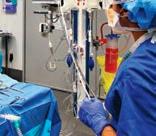














The federal government has just offered the provinces and territories substantial new funding to address the obvious failings in Canada’s health care sector. They have also rightly coupled reform with major improvements in health data collection, including the need for new and better indicators to measure progress. As Prime Minister Justin Trudeau has repeatedly said, “What gets measured gets done.”
But as with all data, the devil is in the details.
What exactly are health outcomes? Are they the same as health indicators? How will they be measured, and how can we ensure they are reported meaningfully and transparently for all Canadians? And most importantly: Will new health data meaningfully improve health care for Canadians?
In health care, for example, indicators can include the percentages of Canadians who have access to a family care team and the number of new family care practitioners; in fact, these are two of the indicators specified by the federal government. But while these are valuable, neither measures a health outcome. Instead, these indicators provide information on volume and accessibility for a key input in health care, namely primary care.
To the extent that these indicators can provide more detail – for example, by ethnicity or socioeconomic sta-
APRIL 2023 ISSUE
EDITORIAL: March 9
ADVERTISING:
Display – March 24 | Material – March 28
Monthly Focus:
Healthcare Transformation/eHealth and EHR/
Mobile Health:
Programs and initiatives that are transforming care and contributing to an effective, accountable and sustainable system including virtual care. Innovations in electronic/digital healthcare, including mHealth and the Electronic Health Record (EHR).
+ ANNUAL E-HEALTH SUPPLEMENT
tus, which should be essential lenses – they can shed light on important issues of equity and timeliness of health care. And as these indicators are tracked over time, they can provide a partial picture of whether health care is improving.
But health-outcome measures go beyond indicators and require more detailed kinds of data.
A health outcome needs to consider a patient’s health status both before and after an intervention, such as a knee replacement or cataract surgery. It’s not just the waiting lists that matter; we also need to know how often a knee replacement has to be redone within a short period of time, or how frequently a cataract surgery fails to improve vision as much as anticipated.
Regularly measuring these kinds of health outcomes is fundamental to learning how well different parts of health care are performing, and whether we are receiving quality health care in the most cost-effective manner.
So how does this understanding of outcomes align with the federal government’s proposed “indicators” and data initiatives requirement? Short answer: we don’t know.
Provinces and territories have control over what health care data are routinely collected.
Continued on page 6
2023
EDITORIAL: April 6
ADVERTISING:
Display – April 21 | Material – April 25
Monthly Focus:
Surgical Procedures/Pain Management/ Palliative Care/Oncology: Non-invasive surgery, plastic surgery, orthopedic surgery and new surgical techniques including organ donation and transplantation procedures. New approaches to pain management and palliative care delivery. Approaches to cancer diagnosis and treatment.
+ NATIONAL NURSING WEEK SUPPLEMENT
THANKS TO OUR ADVERTISERS Hospital News is provided at no cost in hospitals. When you visit our advertisers, please mention you saw their ads in Hospital News.
610 Applewood Crescent, Suite 401 Vaughan Ontario L4K 0E3 TEL. 905.532.2600|FAX 1.888.546.6189 www.hospitalnews.com
Editor Kristie Jones editor@hospitalnews.com
Advertising Representatives
Denise Hodgson denise@hospitalnews.com
Publisher Stefan Dreesen stefan@hospitalnews.com
Accounting Inquiries accountingteam@mediaclassified.ca Circulation Inquiries info@hospitalnews.com
Director of Print Media

Lauren Reid-Sachs Senior Graphic Designer Johannah Lorenzo
Barb Mildon, RN, PHD, CHE
VP Professional Practice & Research & CNE, Ontario Shores Centre for Mental Health Sciences
Helen Reilly, Publicist Health-Care Communications
Bobbi Greenberg, Health care communications
Sarah Quadri Magnotta, Health care communications
Dr. Cory Ross, B.A., MS.C., DC, CSM (OXON), MBA, CHE Vice President, Academic George Brown College, Toronto, ON
ASSOCIATE PARTNERS:
Hospital News is published for hospital health-care professionals, patients, visitors and students. It is available free of charge from distribution racks in hospitals in Ontario. Bulk subscriptions are available for hospitals outside Ontario.
The statements, opinions and viewpoints made or expressed by the writers do not necessarily represent the opinions and views of Hospital News, or the publishers.
Hospital News and Members of the Advisory Board assume no responsibility or liability for claims, statements, opinions or views, written or reported by its contributing writers, including product or service information that is advertised.
Changes of address, notices, subscriptions orders and undeliverable address notifications. Subscription rate in Canada for single copies is $29.40 per year. Send enquiries to: subscriptions@ hospitalnews.com
Canadian Publications mail sales product agreement number 42578518.
Researchers and physicians at Sunnybrook Health Sciences Centre and The Hospital for Sick Children (SickKids) are the first in the world to use MRI-guided focused ultrasound to open the blood-brain barrier and deliver chemotherapy in Diffuse Intrinsic Pontine Glioma (DIPG), an aggressive and terminal pediatric brain tumour. The procedure was done as a safety and feasibility clinical trial in children with this tumour. The first pediatric patient recently successfully underwent the procedure as part of a safety and feasibility clinical trial in children with this tumour.
A challenge for treatment of DIPG is the blood-brain barrier, a protective network of cells, which can prevent therapeutics from reaching areas in the brain. In this Phase I clinical trial, low-intensity focused ultrasound technology is used to temporarily open the blood-brain barrier with the power of soundwaves, allowing drug treatment to cross and treat the brain tumour.
“DIPG is a devastating pediatric brain tumour which is inoperable due to its location in the brainstem,” says Dr. Nir Lipsman, study co-principal investigator, neurosurgeon, and director of Sunnybrook’s Harquail Centre for Neuromodulation. “Focused ultrasound is an innovative and non-invasive approach to more effectively delivering chemotherapy directly to the tumour. Our hope is that this continued research will bring us closer to enhancing treatments to help change the course of the disease.”
“Current treatment for DIPG is limited to radiation, which can slow progression of the tumour for a period of time, but does not have longer-term effects,” says Dr. James Rutka, study co-principal investigator and director Arthur and Sonia Labatt Brain Tumour Research Centre. “Focused ultrasound technology is a promising drug-delivery strategy that is helping us penetrate the blood-brain barrier in a novel way. Conducting this trial will help us build new and innovative treatment pathways for children with DIPG.”
DIPG tumours are the most common form of brain tumour in children under the age of 15 and make up nearly 10 to 15 per cent of all childhood brain tumours. It affects the region of the brainstem known as the pons which regulates the body’s involuntary activities such as breathing, heart rate and important functions such as swallowing. DIPG is considered a terminal cancer.
Clinical and research teams from Sunnybrook and SickKids are collaborating on the clinical trial which will investigate the safety and feasibility of breaching the blood-brain barrier us-
ing MRI-guided focused ultrasound in combination with the delivery of chemotherapy in pediatric patients with DIPG.
The study will include 10 patients between five and 18 years old who have been diagnosed with DIPG. Study participants receive general anesthesia ahead of focused ultrasound treatment at Sunnybrook, which will involve three cycles of chemotherapy about four to six weeks apart. A specialized helmet is used to deliver ultrasound energy to brain targets without requiring scalpels or incisions. SickKids physicians and nurses will assist
with the treatment procedure at Sunnybrook, and the children will receive post-operative care at SickKids.
Low-intensity ultrasound interacts with microscopic bubbles which vibrate causing a temporary opening in the blood-brain barrier that enables therapies to pass and reach a targeted area. The blood brain barrier closes within hours of the procedure.
Sunnybrook is a global leader in focused ultrasound research and is the only Canadian Focused Ultrasound Centre of Excellence as designated by the Focused Ultrasound Foundation.

In 2015, Sunnybrook researchers were the first in the world to investigate low-intensity focused ultrasound in the opening of the blood-brain barrier and delivery of chemotherapy in adult brain cancer, and recently demonstrated in a global first trial that chemotherapy can be delivered across the blood brain barrier in brain metastases.
Sunnybrook has also continued this leading-edge focused ultrasound research in other debilitating brain disease including, Parkinson’s disease, Alzheimer’s disease, Amyotophic Lateral Sclerosis, major depression, and other disorders.

A key driver of this research is philanthropic investment. This study is funded and supported by The Harquail Family through the Harquail Centre for Neuromodulation, the Focused Ultrasound Foundation, and INSIGHTEC as well as by its lead donor at SickKids, Jordana’s Rainbows Foundation and the Fiorini Family, Meagan’s Hug, Nelina’s Hope and The Wiley Family who supported pre-clinical trial work.
SickKids Foundation also acknowledges the generosity of its donors who have supported DIPG research, including: AIan J. Power and Molly Fitzpatrick, ChadTough Defeat DIPG Foundation, Marita Simbul-Lezon and Ron Lezon, Ryan Chisim Charity Golf Tournament, Skate with Daniel, and We Love You Connie Foundation and Guglietti Family, and W. Robert Keyes and Barbara Jackson. n H
The Canadian Cancer Society (CCS) releases findings from a national survey of 700 patients and caregivers and is asking people in Canada to be a Voice for Change to help improve cancer care. The survey, the sixth to be conducted by CCS during the pandemic, was fielded in November 2022 to understand how, and to what extent, people living with cancer and their caregivers are still being impacted by COVID-19. It revealed that, while we are seeing improvements in some aspects of cancer care and support since the peak of the pandemic, access to care remains inconsistent across the country and vital needs are not consistently being met.
Continued from page 4
Among the key findings:
• About 1 in 4 respondents (25%) reported that they are still experiencing cancelled or postponed appointments.
• About one-third of patient respondents (33%) reported that they are not confident they will receive quality care in a timely fashion if they have a cancer-related emergency.
• Caregivers’ inability to accompany patients to cancer treatments or appointments remains the most widely reported disruption for both patients and caregivers, despite changes to many policies to allow 1 caregiver or support person to attend appointments again.
• The majority of patient and caregiver respondents reported that a consulta-
For example, if we really want to know about health outcomes related to primary care, we first need to understand the various ways primary care is currently delivered – whether by solo fee-for-service doctors, or by teams, which include nurse practitioners as well as physicians who are remunerated by capitation, or some other model.
There is enough variety in primary care delivery across Canada that it should be possible to learn what works best by careful and probing comparisons across and within jurisdictions.
We then need to follow samples of individuals over time, to track which mode of primary care organization has patients with fewer illnesses, fewer hospitalizations and longer lives.
It is only with these kinds of longitudinal, person-level data that we’ll be able to produce evidence on which we can base valid indicators of health outcomes and connect them to jurisdictions’ current and evolving ways of providing primary care to their residents.
Will the provinces collaborate, agree on standardized definitions and, with federal financial support, make the investments needed so these critical data become available?
The federal government’s wording on this is ambiguous: “To access their share of the federal funding, including the guaranteed 5 per cent growth top-up payments to the CHT, for the next five years, provincial and territorial governments are asked to commit to improve how health information is collected, shared, used and reported to Canadians to promote greater transparency on results.”
Is this general statement merely cajoling, or is the federal government actually waving a serious fiscal stick? That will ultimately dictate the data outcome because past decades of federal initiatives have repeatedly shown that if Ottawa fails to wield meaningful fiscal penalties, the momentum on serious health care reform is bound to face disappointment. n H
Michael Wolfson is a former assistant chief statistician at Statistics Canada and an adjunct professor in the faculties of medicine and law at the University of Ottawa. David Castle is professor of public administration at the University of Victoria. They both served on the Expert Advisory Group of the Pan-Canadian Health Data Strategy convened by the Public Health Agency of Canada.
tion with a specialist is the most difficult type of medical care to access.
• For patients, the ability to ask questions is the most important support or resource they need to manage their care, whereas caregivers reported financial support is the most important support or resource needed.
“While exhausted healthcare providers are busy doing their very best to get Canadians the life-saving treatments and screenings they need, the cancer care system remains strained, and that needs to change,” says Dr Stuart Edmonds, Executive Vice President of Mission, Research and Advocacy at the Canadian Cancer Society. “With approximately 1.5 million people in Canada currently living with or beyond cancer, we must do everything in our power to ensure the needs of people with cancer and their caregivers are a priority as decision makers address the challenges to our healthcare system.”
The Canadian Cancer Society is calling for everyone, everywhere to get involved in advocating to government to improve cancer care. The Get Better card-writing campaign invites people to use an online tool to create their own get better cards, not for their loved
ones, but to send to elected officials. Through these cards, people can share their stories and the challenges they or a loved one faced when accessing cancer care in Canada, and CCS will print and deliver them to members of Parliament in the spring. The goal is to bring the lived experiences of people impacted by cancer to the forefront to help make cancer care better in all its forms: make early detection of cancer better, make backlogs and delays better, make drug access better, make palliative care better, and more. People can learn more and take action at cancer.ca/GetBetter. The need for improvements to the cancer system has never been more urgent. Based on data from the Canadian Cancer Registry, we know that disruptions to cancer care during the pandemic, including screening and diagnostics, have led to delayed cancer diagnoses and fewer cases diagnosed. In 2020, there were 6.1 per cent fewer new cancer cases compared to the annual average for 2015 to 2019, indicating a significant number of undetected cancer cases that will require treatment and care in the coming years, adding pressure to an already strained healthcare system. n H
According to the 2023 Proof Strategies CanTrust Index, 63 per cent of boomers trust the Canadian healthcare system compared to just 45 per cent of millennials. When it comes to overall trust, Canada’s healthcare system is trusted by 58 per cent of Canadians – a number that is unchanged from 2022. Medical doctors (73 per cent) and scientists (69 per cent) remain the two most trusted groups of people for reliable information, with friends and family in a close third at 68 per cent.
Other insights include:
• After the alarming death tolls in long-term care homes that marked the early phase of the pandemic, 30 per cent of Canadians trust long term care facilities to operate competently and effectively.
• Only half of Gen Z (50 per cent) trust Canada’s public health agencies compared to 69 per cent of boomers.
• Boomers trust pharmaceutical companies more (44 per cent) than Gen Z do (40 per cent.)
• Just over half of Gen Z trust the Canadian healthcare system (56 per cent) compared to 64 per cent of boomers.
• The Canadian Red Cross is the organization Canadians most trust, at 62 per cent.
• Nine per cent of Canadians have “a lot of trust” in federal and provincial leaders to reach collective agreements, with 47 per cent having “some trust.”
• Overall trust among Canadians is up five percentage points from a year ago, at 39 per cent. n H
Midwives have been regulated primary health care providers in BC since 1998, usually providing medical care in pregnancy, birth and up to 3 months after birth.
To understand the outcomes of childbearing people in BC with a midwife as the most responsible provider (MRP) who provided the most care, researchers looked at outcomes of midwifery clients compared with people cared for by a family physician or obstetrician. Of the 425 056 births in the study, 63 151 (14.9%) had a midwife as their MRP, 189 679 (44.6%) a family physician and 172 226 (40.5%) an obstetrician. The proportion of births that had a midwife listed as MRP increased from 9.2% to 19.8% over the study period.
Clients whose MRP was a midwife were less likely to have preterm births and low-birth-weight babies whether at low, moderate or high risk of complications, compared with those with a physician MRP. Cesarean delivery rates increased for midwife clients as medical risk increased but were lower than rates for people with physician MRPs.
“As medical risk increases, both midwives and family physicians collaborate increasingly and appropriately with obstetrician specialists,” writes Dr. Kathrin Stoll, Department of Family Practice, University of British Columbia, with coauthors. “The study provides evidence for the safety and efficacy of midwife-led care across medical risk strata in BC.”
Over the study period (2008–2018), the proportion of people with midwives
as their MPR increased for all low-risk, moderate-risk and high-risk births.
Despite increases in midwifery care during the study period, Canada has some of the lowest rates of midwifery access in the world and increasing rates of cesarean delivery.
“[T]he study provides population-level evidence that midwives provide safe primary care for clients with varied levels of medical risk. If scaled up, the expansion of midwifery in BC holds potential for meeting national mandates to lower obstetric intervention rates and to increase access to midwifery care to under-served communities,” the authors write.
They recommend that expansion of midwifery should be supported by policies and payment structures that enable retention of midwives, health system integration and collaboration with physician colleagues.
In a related editorial, Dr. Shannon Charlebois, a family physician and editor, CMAJ, writes “Midwives can
provide continuity of maternal care and spend an amount of dedicated time with their patients that cannot be matched by physicians” but notes that as other parts of Canada are less advanced in midwifery care, the study findings may not be widely applicable.
“For many people who give birth, midwifery is a safe, evidence-based, appropriate option that they should be able to choose to access,” Dr. Charlebois writes. “For others, obstetric care from a physician may be preferred or more appropriate. Therefore, trust and willingness to collaborate must continue to develop between physicians and their midwife colleagues; this will be enhanced by careful planning of services that can ensure safe systems of integrated obstetric care in all Canadian jurisdictions.”
“Perinatal outcomes of midwife-led care, stratified by medical risk: a retrospective cohort study from British Columbia (2008–2018)” was published February 27, 2023. n H
Nirmatrelvir–ritonavir (Paxlovid) significantly reduced the likelihood of hospitalization or death from COVID-19 in people at risk of severe illness, according to new research in CMAJ (Canadian Medical Association Journal).
The study, conducted by Ontario researchers, aimed to evaluate the effectiveness of nirmatrelvir–ritonavir in preventing severe illness during the emergence of the Omicron variant. They looked at data on adults with mild disease who tested positive for SARS-CoV-2 by polymerase chain reaction (PCR) test between April 4 and August 31, 2022, and compared 8,876 patients treated with nirmatrelvir–ritonavir with 168,669 who were not treated. Most patients were older than 70 years, were vaccinated and had potential drug–drug interactions.
A previous randomized controlled trial, Evaluation of Protease Inhibition for COVID-19 in High-Risk Patients (EPIC-HR), conducted before the emergence of the Omicron variant had found nirmatrelvir–ritonavir to be effective at treating patients. That trial, however, did not include people who had been vacci-
nated or who had potential drug-drug interactions.
“Our study, in conjunction with previous clinical trials and observational research, supports the effectiveness of nirmatrelvir–ritonavir at reducing hospital admission from COVID-19 and allcause death,” writes lead author Dr. Kevin Schwartz, Public Health Ontario and ICES, Toronto, Ontario, with coauthors.
They found that for every 62 people treated with nirmatrelvir–ritonavir, the medication prevented one case of severe COVID-19.
According to Dr. Schwartz, “This study highlights the importance of testing for SARS-CoV-2 if you have symptoms, and access to Paxlovid for those at risk for severe COVID-19. If you test positive for COVID-19, are over 60 years of age, or if you have other risk factors for severe infection, such as chronic medical conditions or are undervaccinated, contact your health care provider or pharmacy within 5 days of symptoms starting and ask about Paxlovid.”
“Population-based evaluation of the effectiveness of nirmatrelvir–ritonavir for reducing hospital admissions and mortality from COVID-19” was published February 13, 2023. n H

Paxlovid substantially reduced risk of hospitalization, death during Omicron wave
Worldwide, it has been estimated that one-third of women have experienced sexual violence from an intimate partner, and seven percent have been sexually abused by non-partners. Although women experience the highest rates of sex and gender-based violence, there is still a lack of knowledge and understanding of sexual violence against boys, men, and trans or non-binary people.
Sexual assault survivors require complex and trauma-sensitive care, which can include medical, psychosocial, and legal support. “Access to urgent healthcare is especially important in some cases, especially when there are physical injuries, possible HIV exposure, or the need for a forensic evidence kit” says Dr. Kari Sampsel, Emergency Physician and Medical Director of The Ottawa Hospital Sexual Assault and Partner Abuse Care Program and assistant professor at the University of Ottawa
Unlike urgent care provided for unintentional injuries, survivors of sexual violence can be uncomfortable disclosing their assault and can have difficulty accessing specialty care services when visiting emergency departments (ED). As a result, many cases are undocumented and untreated. Of those who do seek care in the ED, two-thirds will complete a Sexual Assault Evidence Kit (SAEK) and less than one-third choose to release the kit to the police.
New data shows that healthcare crises, such as the COVID-19 pandemic, also have an impact on survivors’ access to care. In a recent study published in JAMA Network Open, administrative health data at ICES was used to track annual patterns of ED encounters for sexual assault in Ontario, Canada, from January 11, 2019, to September 10, 2021. Within that period there were 10,523 sexual assault cases, with 88 per cent among female individuals.
The authors found that ED encounters for sexual assault unexpectedly increased 20 to 25 per cent just prior to March 2020 lockdown measures, a pattern that was similar across sex, age group, community size, and income levels. Following the first lockdown, cases dropped 50 to 60 per cent and stayed below typical levels seen prior to the pandemic; however, there were seasonal patterns to ED visits, with numbers increasing over the summer months as restrictions eased.
“Rates of ED encounters for sexual assault in the two months leading up to the pandemic could reflect the increased stress in society,” says lead author Dr. Katherine Muldoon, assis-

tant professor at the University of Ottawa, senior research associate at The Ottawa Hospital, and collaborating researcher at ICES. “We know from previous research that job insecurity, financial-related stress, and social isolation are all factors that increase the risk for violence.”
Dr. Muldoon says that the findings from this study underline the need for specialized clinics within emergency departments, where physicians and staff are trained in how to provide trauma-informed care. “Specialized clinics are the best solution for encouraging survivors to come to EDs following a sexual assault,” she says. “However, clinics need to be accessible even
during healthcare emergencies, and communication should be clear that survivors can visit the emergency department despite public health restrictions,” she says.
In the province of Ontario, there are currently 37 Sexual Assault/Domestic Violence Treatment Centres, out of close to 200 emergency departments. This network of specialized clinics aims to address health, psycho-social, and forensic needs of survivors of sexual violence and/or domestic violence.
“The goal of trauma-informed care is to minimize the chance that survivors will feel re-traumatized when they seek health care,” says Dr. Kari Sampsel. “If a survivor doesn’t present for care because they think they won’t get the care they need – maybe because they can’t access a specialized treatment program, or if they think the ED is too busy – then we’re really only seeing a fraction of cases that occur in the general population.”
Survivors may choose not to seek medical care at all or will turn to community-based organizations and other non-hospital services. While these services are vital for emotional support and information, there can be longterm effects for people who have survived violence but who didn’t get the medical care they needed.
Additionally, the culture of shame, silence, and stigma around sexual assault are factors that perpetuate violence and continue to allow predators to prey on people, from children to elders. ‘Most sexual assaults are committed by a known perpetrator and this can make it harder to come to healthcare system for care if someone is still living with the perpetrator” says Dr. Muldoon.
As the province of Ontario continues to experience disruptions to emergency care and overcrowding in the ED, it is just as important as ever to improve public education and develop policies that address the barriers that survivors of sexual violence continue to face. n H
THERE CAN BE LONG-TERM EFFECTS FOR PEOPLE WHO HAVE SURVIVED VIOLENCE BUT WHO DIDN’T GET THE MEDICAL CARE THEY NEEDED.
As a primary care physician in a practice that sees a lot of elderly patients with complex care needs, I’m often working with a range of specialists to deliver care. This means my patients go through a number of transitions in care, which can be more complicated than people may realize, as data doesn’t always flow efficiently across our health care system.

That’s why I was encouraged to see an increased focus on health data included within the federal government proposal on health care funding that was recently accepted by Canada’s Premiers. I know from my clinical experience that digital tools can play a powerful role in supporting patient care by enabling more comprehensive access to health data.
I recently saw a patient for a follow-up appointment, and we were missing two specialist consultation records that I have no way of accessing except through a fax request. If I’m lucky, I’ll have the records within a few weeks and will then be able to have a more comprehensive discussion with my patient on a follow-up care plan. Unfortunately, I’m not alone in these struggles. Research commissioned by Canada Health Infoway found that 82 per cent of clinicians report not always having a summary of patient care received outside their practice setting, with 92 per cent wasting time searching for patient information from other care settings.
Any time an element of a patient’s care is transferred to another member of their care team, whether to a specialist, pharmacist or allied health provider, it takes much more time than most Canadians might realize. And this doesn’t even consider the approximately five million Canadians who do not have a family physician and may rely on walk-in clinics or emergency departments for care, without the ability to access their medical records.
Consider for example an elderly patient transitioning to community care from a hospital, after experiencing a stroke. Elements of the patient’s history and care will be split across my office, the hospital, specialist teams and perhaps even home care teams. Without an efficient way to share this information, it places a heavy administrative burden on an already-stretched health care team.
These situations will only increase in frequency as our population ages. In approximately eight years, Canada will experience a rapid increase in the number of people older than 85. These are our most vulnerable citizens, with many comorbidities and highly complex care needs. My colleagues and I already spend more time than we have on charting, specialist referrals, forms, coordinating preventive care, and oth-
er time-intensive tasks. With a more connected health care system, we can get ahead of some needless administrative inefficiencies, and ensure that more time can be spent on providing care to patients.
This is where the work I do as Clinician Leader at Canada Health Infoway comes into play. We are excited to partner with the federal government, provinces and territories, the private sector, and the health workforce to co-author the next chapter of health system modernization. Improved interoperability – the ability of health technology systems to “speak the same language” based on the use of common standards – is a key piece of this, as it enables better access to, and secure sharing of, patient health data.
In a more connected health care system, clinicians and patients benefit through better and more integrated care delivery across care settings, more effective communication across care teams, improved service delivery, and more efficient workflows. Secure collection, sharing and use of health information will enable system improvements through the application of advanced analytics. A digitally connected health system will also save time for, and reduce the stress of, our health care providers, who continue to bear the brunt of delivering care on the front lines.
I was pleased to see our federal health minister recognize this in his comments a few weeks ago, noting that “we must work together to collect, share, and use health information to strengthen and improve the delivery of health care while continuing to support our health care workers.” I couldn’t agree more. I welcome the opportunity to work more efficiently with colleagues across the health care spectrum, using better health information sharing to enable all of us to spend more time where it matters most – on patient care. ■ H
I KNOW FROM MY CLINICAL EXPERIENCE THAT DIGITAL TOOLS CAN PLAY A POWERFUL ROLE IN SUPPORTING PATIENT CARE BY ENABLING MORE COMPREHENSIVE ACCESS TO HEALTH DATA.Dr. Rashaad Bhyat is a Toronto physician and Clinician Leader at Canada Health Infoway.
Michael Garron Hospital (MGH) opened Ontario’s newest hospital facility, the Ken and Marilyn Thomson Patient Care Centre (Thomson Centre), in February, ushering in a new era of healthcare for East Toronto.

The state-of-the-art, LEED-certified building features 215 inpatient beds and two floors of brand-new outpatient clinics across eight floors and 550,000 square feet.
It was built using best practices in clinical design to provide a safe and supportive healing environment, and incorporates environmentally friendly and innovative technologies that help improve the experiences of patients and staff alike.
In addition, the Thomson Centre was developed with East Toronto residents in mind, helping to address the unique healthcare needs of an area that is comprised of some of Ontario’s most diverse communities.
“The Thomson Centre gives me hope for the future of healthcare in East Toronto,” says Razia Rashed, a community member and patient at MGH whose family has received care at the hospital for three generations.
“As a community hospital, MGH provides high-quality specialized care
close to home for East Toronto residents,” adds Wolf Klassen, President and CEO, Interim at MGH.
“Our teams are excited to care for patients in a modern, state-of-the-art facility that the community deserves.”
The East Toronto community has a broad spectrum of health and social care needs, including a higher prevalence of chronic, complex illnesses and mental health challenges than the general population.
To address these needs, MGH placed three of the hospital’s largest chronic disease outpatient programs beside one another in one dedicated space in the Thomson Centre. This helps make frequent visits more convenient for patients and allows teams to collaborate more effectively on patient care.
Each inpatient floor was designed with best practices around infection control and prevention. Eighty percent of rooms are single-occupancy, and all rooms – even double-occupancy ones – have a private bathroom.
In addition, negative pressure isolation rooms are available for patients who may be infectious.
These spaces offer patients lightfilled surroundings and greater priva-

cy, bringing dignity and respite as they heal and recover.
With the opening of the Thomson Centre, MGH has integrated its new and existing technologies as much as possible so they “speak” to one another across the legacy campus and new building. This helps make patient care more efficient across the entire hospital.
New technology includes safety bracelets for patients at high risk of wandering, staff duress badges and medical equipment tracking.
These are connected to a real-time location system (RTLS), which sends signals to ceiling-mounted monitors to help determine the exact location of equipment and consenting individuals
The new RTLS technology also makes it easier to contact trace in cases of infection or outbreak and streamlines the documentation of hand hygiene compliance among staff, credentialed clinicians and learners.
The Thomson Centre has many efriendly features that help improve the comfort and well-being of everyone in the hospital while also helping
MGH minimize its environmental footprint for years to come.
These features include a green roof, which helps produce cleaner air and reduce stormwater runoff; and two terraces, which provide greenery, shaded spaces and sunlight for staff and patients to enjoy.

The terraces also offer a safe, non-clinical space for staff, patients, caregivers and visitors to relax, and may be beneficial for healing and reducing stress.
Other environmentally friendly features in the Thomson Centre include high-efficiency boilers and LED lights, which help reduce the hospital’s overall energy output.
This sustainable design has earned MGH a Leadership in Energy and Environmental Design (LEED) Silver certification for the Thomson Centre.
LEED-certified buildings produce less greenhouse gas emissions, conserve water and energy and create healthier environments for people. It is a globally recognized sign of sustainability achievement and leadership.
While the Thomson Centre is the centrepiece of MGH’s campus transformation, the larger project will continue until 2024 with renovations to existing areas of the hospital, decommissioning of outdated wings and new greenery and landscaping to welcome the community to the new facility. n H
Regan Lalonde is a Communications and Community Engagement Coordinator at Michael Garron Hospital.The global pandemic has shone a light on the unique challenges in Canada’s long-term care (LTC) sector. CSA Group has recently published a new national standard CSA Z8004:22, Long-term care home operations and infection prevention and control, that aims to help create safer LTC homes.

While the Standard was developed by CSA Group members - experts across a range of different areas representing various stakeholders and perspectives, it was informed by insights and experiences of LTC homes residents, their families communities, caregivers, and staff. In the public consultation sessions and surveys, they emphasized that LTC facilities should first and foremost feel like homes for their residents. This notion is reflected in the driving principles of the new Standard: person-centred care balancing residents’ autonomy and safety, equity, diversity, and inclusion (EDI), and gender and sexual inclusivity.
The CSA Z8004:22 standard covers topics including:
• Organizational commitments. LTC providers and management are encouraged to embrace collaborative decision-making and principles of person-centred care, EDI, and gender and sexual inclusivity in order to create an inclusive and supportive environment for residents and staff. Design, IPAC policies and procedures, and operations in LTC homes should meet the needs of residents and ensure their safety, autonomy, and respect for cultural and religious differences. LTC providers and management should also promote and support positive interactions
and relationship-building between staff and residents, their families, and caregivers.
• Operations and catastrophic event management. The guidance for LTC home operations includes recommendations for meaningful activities based on knowing residents and their abilities. The Standard helps establish policies and procedures for visitors, including support for visitation during outbreaks, epidemics, or pandemics, and offers provisions for cleaning and other environmental services that contribute to clean and sanitary environments within LTC homes.
Food and nutrition management is an important part of the Standard, with recommendations to create tailored and culturally appropriate meal plans and provide mealtime flexibility and environments that promote quality of life.
The Standard also helps LTC homes develop plans to minimize operations disruptions during extreme weather events, loss of power, airborne and organic contamination, or other catastrophic events.
• Infection prevention and control (IPAC). The Standard can assist LTC homes in developing and implementing IPAC programs based on best practices, guidelines, and recommendations from national and international authorities and the scientific literature. It recognizes the importance of hand hygiene and personal protective equipment, as well as cleaning and disinfection policies and procedures.
• Design, building systems, and information technology (IT). The Standard promotes the residential design of LTC homes, maximizing the dignity, privacy, and autonomy of residents and connection of LTC homes with surrounding communities. The recommendations apply to residents’ bedrooms and washrooms as well as visitor and outdoor spaces, kitchen, dining, and laundry areas, and also address materials, finishes, furniture, fittings, equipment, signage, and wayfinding systems.
Building systems, such as electrical, plumbing, HVAC, and medical gas systems or electronic build-
ing and security systems contribute to a safe and comfortable environment for residents, staff, and visitors of LTC homes. CSA Z8004:22 provides requirements and recommendations for their design and maintenance.
IT plays an important role in keeping LTC home residents connected with their families and care providers. The Standard guides LTCH homes through the design, selection, and implementation of IT systems, as well as data management and privacy.
• Training and simulation. The Standard also outlines training and education LTC homes staff should receive on various topics, including sexual expression and intimacy, inclusive language, waste management, IPAC, IT systems, and catastrophic event management.
A set of self-directed and instructor-led online courses can help LTC homes administrators and staff, architects, health care engineers, and other stakeholders better understand the requirements and recommendations of the new Standard and their application. These courses cover operations, management, and maintenance of LTC homes, person-centered care, and IPAC in LTC homes.
CSA Group is also having ongoing conversations with various government and industry stakeholders to help ensure that they have the information and tools needed to voluntarily utilize CSA Z8004:22 and consider it for potential referencing in regulations.
For more information on the new standard CSA Z8004 and training related to LTC homes, visit www.csagroup.org/LTCStandard.
On a busy day in St. Michael’s Hospital’s surgical unit, the care team can look after upwards of 42 patients, coordinating everything from pain management to wound treatment to deciding when patients can go home.
In November, Unity Health Toronto introduced a new Artificial Intelligence (AI) solution, CHARTWatch Surgical, in partnership with Signal 1, a Canadian health AI startup. CHARTWatch Surgical uses patient data on the hospital’s existing electronic medical record – such as the diagnostic test results and patient vitals – to predict the level of support a patient will need. This insight, paired with clinical expertise, is helping the care teams communicate and make decisions.
A similar tool has already been in place on St. Michael’s General Internal Medicine unit since 2020. Preliminary data show the tool, which predicts when patients are at risk of getting sicker or being transferred to intensive care, has led to a significant drop in mortality among patients who were flagged as ‘high risk’. While CHARTWatch is a new tool for the surgical unit, they are already seeing benefits.
Charge nurses – the lead nurses who assist with operations of the unit – have been critical to the rollout of CHARTWatch Surgical. Every morning and evening, they receive a full CHARTWatch report via email, telling them whether patients are at low, medium or high risk. Throughout their shift, they also receive alerts if a patients’ status changes to high risk.
“As charge nurses, we have the responsibility to scan that email or
pay attention to those high alerts, and then to notify the bedside nurses caring for those patients on the unit and notify the surgical team doctors,” says Ruth Mega, a charge nurse on 16CCN.
The information from CHARTWatch helps Mega and her colleagues to plan their shift.
“As a bedside nurse, if I have five patients, I will start my shift with that high alert patient,” says Mega. “It helps you prioritize your day and then you are more proactive as opposed to just being reactive.”
Dr. Reza Gholami, a physician on the unit who primarily cares
for gastroenterology patients, finds CHARTWatch makes his work more efficient.
“During my shift, I will round with every patient and I usually have somewhere between 10 to 15 patients,” says Gholami. “I will get a good idea from CHARTWatch of which patients I should pay more attention to, and even see first.”
CHARTWatch also makes it easier for charge nurses to plan nursing assignments for the incoming shift.
“We’re mindful to assign the high acuity patients evenly across the team to ensure that assignments are safely divided,” says Mega.
CHARTWatch is also strengthening communication across the team.
“What we’re seeing with CHARTWatch is improved teamwork on the unit and improved communication between the nursing and physician teams,” says Swanee Tobin, clinical leader manager for 16CCN.

For example, the unit has included CHARTWatch in their daily quality huddles on the unit.
“Every person that is on the unit at that time is engaged in the huddle and CHARTWatch is part of the conversation,” says Tobin. “Everybody is aware that the patient in a particular bed is high on CHARTWatch, and to keep an eye on them.”
“The main positive impact is creating a strong focus on the sickest patients,” says Gholami. “Everyone on the floor is more sensitized to those patients so they get the care that they need.”
The team continues to work closely with Signal 1 and Unity Health’s Data Science and Advanced Analytics team to refine the CHARTWatch Surgical platform. They also continue to gather and analyze data to see if the platform is having a positive impact on patient outcomes on the unit. As the team more closely monitors patients who are at high risk, they hope to see fewer medical emergencies and intensive care transfers.
“CHARTWatch gives you that added reassurance and validation,” says Mega. “There’s a reason these patients are flagged. It doesn’t replace your clinical intelligence, but it definitely helps to enable better patient outcomes.” n H
“THE MAIN POSITIVE IMPACT IS CREATING A STRONG FOCUS ON THE SICKEST PATIENTS.”Robyn Cox is the senior communications advisor at Unity Health Toronto

Stop using last century’s technology for prescriptions. Evolve to true e-prescribing with PrescribeIT®. It integrates directly into your EMR and protects patient privacy. No more transmission failures, and no more back and forth phone calls and faxes to clarify prescriptions. Enjoy the benefits of enhanced medication safety. Learn more at PrescribeIT.ca
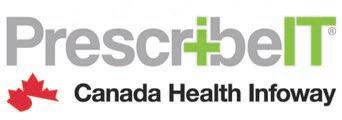
Many of us worry about the negative impacts of climate change and wonder what, if anything, we might do about it in our daily lives. We may make changes such as recycling at home and biking instead of taking the car, but we don’t realize the magnitude of impact we as healthcare leaders can have at work by promoting and supporting a culture of sustainability. As it turns out, the health care sector contributes approximately five percent of the total carbon footprint of our country. This is more than the airline industry! Healthcare is a high emission business and there are massive opportunities to lessen our carbon footprint and put us on the road to sustainability.
Together with other healthcare leaders, PEACH Health Ontario (https://www.peachhealthontario. com) helps to educate hospital leaders, and their employees, on the numerous ways a healthcare organization can get to ‘carbon zero.’ In an effort to help senior leaders, PEACH, in collaboration with the Canadian Coalition for Green Health Care, created a simple guidebook titled “Environmental Stewardship: An implementation Guide for boards, executive leaders, and clinical staff: Meeting hospital standards and beyond.” It provides an overview of some of the key steps and actions that senior leaders can initiate and support for their hospital to move towards a climate-resilient, carbon net-zero, and environmentally sustainable health system.
The rationale behind the guidebook was to create a learning tool which was easy to read, provided a roadmap for leaders, and contained a section which showed the largest greenhouse gas (GHG) saving items to pursue. A checklist in the guidebook illustrates that in order to effectively manage GHG emissions, one needs environmental leaders from many different hospital departments involved in the effort!
Implementation of a Sustainability Strategy
Appoint a leadership person for sustainability
Divest foundation funds from fossil fuels to low-carbon funds
The Choosing Wisely Canada (CWC) program was developed to educate clinicians on minimizing unnecessary tests and investigations. Hospitals can be recognized for their efforts.
Recognized by CWC as a "Using Blood Wisely Hospital"
Recognized by CWC as a "Using Labs Wisely Hospital"
Recognized by CWC as a "CWC Hospital"

Facility uses reusable gowns and linens
Hospital has a reusable sharps container program, or equivalent
financial and environmental savings.
Operating room (OR) reduces waste by having pick lists for each surgeon
Meant to optimize OR efficiency, operative pick lists, or surgeon’s preference cards, indicate which surgical instruments need to be opened for a given procedure. Studies show that up to 87% of opened items are not used; thus, streamlining lists reduces waste of instruments and instrument wrapping material, reduces emissions required to reprocess and transport instruments, and leads to overall cost reductions.
Pharmacy has a sustainable prescribing strategy
Sustainable prescribing is done to decrease unnecessary medications, errors, interactions, and side effects. It is also important because pharmaceutical production and disposal release a significant amount of GHGs.
We studied the GHG equivalents of 40 of the most common initiatives which hospitals consider to decrease emissions. All of the items were standardized to the same hospital size over the course of a year, and we calculated what the corresponding GHG savings would be. We also considered the cost of the various initiatives. This resulted in the 22 action items listed in the diagram. We found that some of the usual suspects, like replacing boilers and taking active transport to work, did end up on the checklist of high impact items. There were some cost-neutral items which had a major GHG impact, such as increasing plant-rich menu options and adopting sustainable procurement practices. And the items which can actually save money for the organization include such actions as de-prescribing medications and reducing the ventilation rates of operating rooms at night. Most of the items either save money, or cost relatively little.
Desflurane is minimized to less than 5% of OR gases
Anesthetic gases are released directly into the atmosphere following their use, and exert considerable greenhouse effects (higher than CO2). From these, desflurane has the worst GHG burden in comparison to other gases (2200 times more than CO2).
Heating, Ventilation and Air Conditioning (HVAC) Systems are energy efficient
Older generation boilers and chillers produce most of a facility's GHGs. Upgrading to energy-efficient HVAC systems, using ground, air or water sources heat pumps, using wind or solar to generate electricity can further reduce GHGs.
Over 90% of the facility has been converted to LED lighting
Replacing old light fixtures with modern energy-efficient LED fixtures can significantly reduce energy expenditures.
OR ventilation is set back to 8 to 10 cycles per hour, or lower, overnight
Other countries (such as the UK) do not run their OR ventilation at full settings during off-hours, whereas in Canada hospitals may not ‘set-back’ their ventilation settings because of safety concerns regarding infectious diseases. However, there is no evidence that this is an unsafe practice.
Facility, or proposed new build, is LEED Gold standard or higher
New builds operate with minimal GHG emissions.
Facility has a dedicated energy manager or equivalent consultation service
A dedicated energy manager is hired to oversee and optimize all aspects of a hospital’s energy use, and coordinate programs through the hospital.

Plant-based food options to patients are increased by 25%
GHG reductions are associated with providing a more plant-based diet and decreasing the quantity of meat products offered to patients.
Hospital uses a composter for food waste
An aerating composter, whether on-site or as part of municipal waste management system, decreases the amount of GHGs released by food waste.

Facility has a secure area to store bikes, or other accommodations that encourage bike riding
Installment of bike stations (ranging in size and cost) can encourage employees to bike to work by providing a safe location to store bikes.
Min. 2% of parking spaces at the facilit y are dedicated to carpooling or EV charging

Car travel by staff, patients and visitors is a significant contributor to GHG emissions within health care. Therefore, encouraging carpooling can decrease environmental impact.
The facility has 25% green cover including green roof, food gardens, tree canopy, pollinator gardens and natural grass (except lawns)
Plants absorb CO2 and reduce heat island effect. They provide beauty and evidence suggests plants lead to improved patient outcomes.
While the list of potential actions may seem daunting, it is important to break it down into manageable elements while taking advantage of the growing list of resources available to assist. We are seeing an increasing number of hospital organizations developing sustainability strategies and taking on the challenges of reducing their GHGs and ecological footprint. Most senior-level decision-makers are in positions to oversee drastic reductions in their organization’s GHG emissions.
By way of additional examples, an anesthetist stopping the use of the anesthetic gas desflurane can have a significant impact on an organisation’s overall GHG emissions. A food service or nutrition manager switching to a more plant-rich diet or decreasing food waste can also do their part for a healthier planet.
Finally, consider the impact of a hospital financial lead divesting their foundation’s investments of fossil fuel
stocks! For those who want to do a deeper dive, and truly want to wow the people from Accreditation Canada, which has recently introduced new sustainability standards, the Coalition for Green Health Care offers the Green Hospital Scorecard. Started in 2016, the Scorecard allows you to go into a detailed look at various departments, and provides a data-driven outcomes score highlighting your successes and where you have room for growth. Participating hospitals are automatically part of the yearly awards process. In short, once your baseline is created, you are scored in successive years and compared to your own score and that of your peers. https://greenhealthcare. ca/ghs/ Climate change is a significant societal problem, but fortunately it is a problem we can mitigate. As health care leaders we are in positions of influence, and can step forward, empower our colleagues, and make great change happen! Visit www.greenhealthcare. ca to learn more. n H
Health Ontario – myles@greenhealthcare.ca

Diagram 1: The top action items to decrease the CO2 emissions of a hospital

















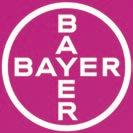




We had one chance to get it right,” says Christopher Rizzo, Executive Director of Redevelopment, University Health Network, “Building two mini-operating rooms in a live suite of twenty sterile ORs. We’re talking about a city of individuals that are having different surgeries in sixteen to eighteen ORs at any one time.”
“The first day we did our site review was the day that COVID hit,” says Keith Button, Senior Architectural Designer at Kearns Mancini Architects (KMAI), “We were on site when everything locked down. We had to get the Director of Infection Control at UHN to help us exit the hospital.”
Not the typical start to a new project, but then again this is the most unique project on the planet. Rizzo and Button are speaking about the design and building of the world’s first Organ Regeneration Laboratory (ORL) at Toronto General Hospital (TGH), the number one transplant hospital in North America.
The TGH transplant surgeons who developed the regeneration technologies had been honing their techniques
in an existing operating room. ORs can be up to 700 to 1,200 square feet so it was overkill for their spatial needs and not the best use of precious hospital resources. They brought the concept of a dedicated lab to Rizzo.
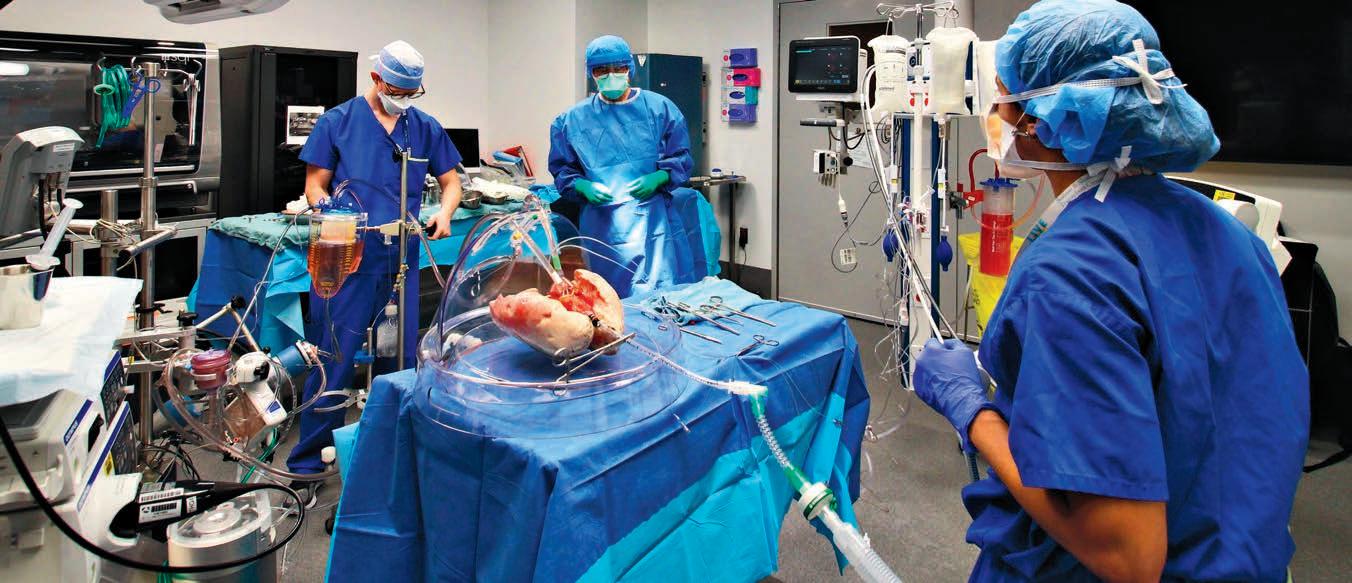
In the past, if organs were in any sort of trauma, if they weren’t perfect, they couldn’t be transplanted. The organ regeneration lab is using technology that was perfected at Toronto General; it’s called perfusion. Perfusion effectively keeps the organ alive for an extended period in a specialized environment like an incubator, which gives the team time to work on the organs and get them ready for transplant.
“Covid shut down elective surgeries,” says Button, “the ORL project freed up one of the ORs that they were using for a jerry-rigged version of the regeneration lab. Time was tight. We had to do the work as fast as we could so that the additional OR could be used to deal with the surgical backlog created by COVID.”
“These are the projects you do once in your life.” Rizzo says. “Two designated mini-ORs that have created the
ability to regenerate or repair organs for transplant. There’s a third area which is called the islet room that harvests stem cells from a pancreas, and is being used to treat diabetes, reversing the effect of the disease in some patients.”
Toronto General completes 12001400 transplants a year, with a success rate hovering around 98 per cent.
“We’re in pretty esteemed company on a global scale,” says Rizzo, “we were the first to transplant a lung and the first to transplant double lungs. Right now, if a recipient needs double lungs, they are getting them in one operation. Our track record is probably the best you can get for surviving major transplants.”
Ground-breaking work is being done in these facilities, but breaking ground to build them was just as challenging.
“It was like playing Tetris in a fully functioning operating ward,” says Button, “we couldn’t do one thing without it affecting something else. We had to free up three rooms that were already in use. One for perfusionists, another for anaesthetists and an equipment
storage room. Just to free up these three rooms we had to renovate 12 locations in the hospital – most of them in the operating suite itself.”
Due to the tight schedule and a need for experienced team players, the design-build team of Dineen Construction and Kearns Mancini Architects was selected to deliver the project.
“From start to finish,” commented Rizzo, “we did the project in less than 12 months, so it was a monumental task.”
The greatest concern for the surgeons was headroom. A lot of equipment on articulated arms is hung from the ceiling in a typical OR. There needed to be enough clearance so that the equipment did not clash, however ORs normally have a 10-to-12-foot ceiling height. The rooms being renovated for the regeneration lab did not have more than 8 feet of headroom. The design/build team from Dineen/ KMAI had to work with manufacturers of the lighting and equipment booms to have the least possible depth of the equipment overhead.
Continued on page 18






In Medical Solutions, Essity provides innovative, high quality medical products for advanced wound care with leading brand Cutimed®.

Developed specifically for management of chronic and complex wounds, Cutimed® provides reliable and innovative product solutions that promote wound healing for all stages of chronic and complex wounds. Siltec®




Silicone foam dressing utilizing hydrophobic microbe-binding layer for excellent fluid and infection management.


Infection management for chronic wounds utilizing a purely physical mode of action.


Fast and e ective wound cleansing.
Super absorbent dressing that also manages bacteria.


“Because we are the biggest teaching facility in Canada,” Rizzo pointed out, “and probably ranked highly in North America in teaching, we have about 1700-1800 fellows that we teach. So, as we’re doing all this stuff, we’re teaching doctors from all over the world so they can take it back to their own place, where they live, where they work.”
The Organ Regeneration Lab is a lab and a studio at the same time. What you see in the OR is a large light fixture with high intensity lighting for the work over the organ. Everything in the room is done under high-definition video recording, so it can be viewed in any part of the world as it is happening. A 4K high-resolution camera built-in within the light fixture is centred perfectly over the surgeon’s table. There are microphones and speakers all over the ceiling. While the surgeons are working in the lab, they are also teaching other professionals around the world how to perform the work.
For Rizzo, “one of the biggest aspects was to put in a dedicated medical grade air handling unit to provide the air changes that were required for an ultra-sterile environment.”
“The islet room is considered on par with a pharmaceutical lab,” adds Button, “it requires 40 air changes an hour. The bio-hood in that room worked in reverse. They are dealing with cell cultures. Normally a hood would be protecting you, but here the hood was protecting what was in the hood from you. The room must be HEPA filtered and positively pressurized. So, the mechanical systems were enormous. A completely independent system.”
These two labs had to remove pathogens. Most organs are worked on within a glass box, so they are not exposed to the room proper. They are within their own environment, but the rooms must be ultra-sterile.
“This is cutting edge.” says Rizzo, “The intricate layout means you must
be quite disciplined. The ergonomics had to be tested and proven in detail. Where is the med gas? Are the services within reaching distance of the surgeons in a very tight space? When the surgeon is working around the medical bench – where they work shoulder to shoulder – there must enough freedom for the surgeons to do their job, but the equipment must be right at their side so it’s within reach. The sightlines, the lighting, the microphones. It’s all recorded. So, viewers can see it in real time.”
Button spent weeks meeting with their partners, Dineen Construction. The tight tolerances. Putting everything within reach. Plotting out the ergonomics. Trying to gain 5 millimeters in ceiling height to hang equipment. There was so little space above the ceiling in the islet room that they couldn’t suspend the ceiling. It had to be supported from underneath.
How do you build within a sterile environment during a Covid lockdown?
“The trades had to go through the OR suites to access the regeneration rooms.” says Button, “They gowned up like they were surgeons. When they


made it through COVID protocols they ditched their street clothes and switched into scrubs. Eventually, the contractors gave them scrubs to put over street clothes. Masks and hairnets. They would come in to do their work, then dispose of their PPE. There was no coming and going. None. The trades on site had to stay there for the entire day.”
“Kearns Mancini asked all the right questions,” says Rizzo, “They understood the sensitivities. They understood that they couldn’t breech a sterile environment, so following the rule to gown up in the area, removing gowns just like the medical staff and being precise in the way they executed the project was no different than the precision of the surgeons. A very successful project. Our number one win of the year.”
For Rizzo, Kearns Mancini distinguishes themselves from other firms. “KMAI rises to the occasion like a commando unit. They will study it and identify what they don’t know to ask all the right questions, to get it right. They will educate themselves. They put a lot of time and effort into figuring it out.”
Fundamentals of Health
is specifically designed to help prepare learners of all academic backgrounds for meaningful new positions in health care, and provides foundational knowledge for further post-secondary education.
Christopher Rizzo points out that KMAI is very passionate about the environment, very passionate about raising the bar and doing things better. And taking a bit of a calculated risk. Their experience gleaned from being Ontario’s Leading Passive House architects helps because they understand isolating air and moving air.
“KMAI is pushing the envelope in how to solve a problem,” says Rizzo, “it’s a personal journey for them. They collaborate with the best of the best of the mechanical and electrical in the field. They are one of the firms that really care about learning what they don’t know. It works to their benefit. It’s the right approach. The errors are impactful if they are not figured out. They did a lot of verification and cross verification. That’s why we enjoy working with them.”

“This is an historic first.” says Button” We knew it was new and badly needed. So, we went out of our way to get it done. Pushing the envelope of what we could do. I like to know what we’re doing and why. It informs the decisions. It did not feel wrong to pump for information.”
“We were able to do something that is helping a lot of people,” reflects Button, “Beyond that we freed up an OR that is now back up to full operation. The hospital gained the extra capacity it needs with so many postponed surgeries.”

“These procedures are going to change what is done across the plan-


et.” says Rizzo, “We have the talent here, thank goodness! We have the people that are dedicated to perfect and retain what we got right.”




“The idea of getting organs and restoring them.” marvels Button, “I still have the vivid memory of seeing a set of lungs under a bell jar, plumbed up
with fluids and air, seeing them expand and contract.”
“An amazing story,” recalls Rizzo, “an amazing journey about something that is cutting edge and that is going to help save many, many people. We don’t tell our story enough, for such a small country, Canada n H
Health-care facilities like hospitals and long-term care homes are energy-intensive places. And their energy demands can get costly.
But organizations like Providence Health Care in Vancouver are finding ways to care for its long-term care residents while lowering its environmental impact.
In collaboration with FortisBC, it has implemented innovative and cost-effective energy-efficiency upgrades to its heating equipment at one of its long-term care homes in Vancouver.

It has gone a step further by subscribing to FortisBC’s Renewable Natural Gas (RNG) program –the first British Columbia health-care organization to do this–which is helping to decarbonize its operations even more.
Together, these efforts are helping lower annual operational costs, reduce greenhouse gas (GHG) emissions all while ensuring access to reliable energy through the gas system. This project is also serving as a blueprint for use in its other long-term care homes.
Providence operates acute-care hospitals and long-term care sites in Vancouver. Compassionate, respectful care is at the heart of everything it does.
For more than 10 years, Providence and FortisBC have worked together to improve the energy efficiency of Providence’s facilities. That is helping reduce energy costs.
“Patients and residents are the reason we do what we do, and why we
continue to look for opportunities to make improvements that have a positive impact,” says Anthony Munster, Executive Director of Projects, Planning and Facilities Management at Providence. “Improving operations through energy efficiency upgrades allows us to make spaces more comfortable while also reducing our environmental impact and meeting our climate action goals.”
To better understand what type of upgrades would make a positive impact at its facilities, Providence listened to the feedback and concerns of residents. Recent summer heat domes prompted conversations around the need to add cooling into long-term care homes and make these spaces more comfortable for residents.
With this, Providence looked into adding cooling to one of its buildings. It then realized there was an opportunity to add cooling and save energy and lower GHG emissions by upgrading the heating system.
Providence chose its St. Vincent’s: Brock Fahrni long-term care home in Vancouver to install a new high-efficiency heating and cooling system. Brock Fahrni is home to 148 residents, many of them armed forces veterans.
By replacing older equipment with high-efficiency technology, Providence found an opportunity to improve multiple systems at Brock Fahrni. A key consideration with these upgrades was to ensure it continued to have access to reliable energy. It uses a significant amount of energy across its sites, from heating to sterilization and laundry.
“FortisBC’s ability to provide us with a reliable source of low carbon Renewable Natural Gas has been essential in ensuring the success of this project,”
says Munster. “They have supported us in finding the best way forward and covered some of the costs for this new high-efficiency equipment that is helping us achieve our organizational goals. We look forward to working together to roll out similar initiatives at our other sites.”
Providence realized it could continue to use gas in its operations while making it more energy efficient by capturing what would be wasted heat and making it usable. There was potential to reuse warm exhausted air throughout the building to lower energy consumption and we found a technology, called a thermal gradient header, which could do just that.
A thermal gradient header system is designed to transfer thermal energy through a set of connected pipes. This efficient technology provides simultaneous heating and cooling, essentially functioning as a smart hub for thermal energy that is transported to different zones based on the energy demands of the building. On top of that, Providence installed a high-efficiency condensing boiler to meet the heating demands of the building
when there isn’t enough waste heat generated by the thermal gradient header system.
Providence also looked to change the way it received energy at the long-term care home. It was decided that Providence would receive energy directly from FortisBC rather than using energy generated from a nearby steam plant, which is typically less efficient. By cutting out the need for steam heating and with the addition of a new boiler, Providence improved the efficiency of its operations. This also created an opportunity for Providence to further reduce its environmental impact.
By working with Elizabeth Manhas, a key account manager at FortisBC, Providence learned it could further reduce GHG emissions through the energy company’s RNG program. FortisBC customers can subscribe to this program to designate a portion of their gas use as low-carbon RNG.
Continued on page 22
Sometimes the care team needs a care plan.
The MCC 360 multi-source feedback and coaching program helps physicians build their communication, collaboration, and professional skills. The research-backed program gives each physician an individual report, 1:1 coaching, and CPD credits.

Get started at mcc.ca/360
EMPATHY LISTENING PATIENCE
TIME-MANAGEMENT TRUST
CLARITY
ORGANIZATION
RESPONSIVENESS RESPECT
MCC 360. Get better.
Providence Health Care is the first health care organization to sign up for the program and is now designating 100 per cent of its gas use at this care home as RNG.
Providence is seeing the benefits from the project. It lowered its annual energy use at the facility by more than 10,500 gigajoules, the energy equivalent to heating almost 125 homes for a year. It’s also saving around $100,000 in annual operational costs which helped cover the cost of becoming an RNG customer without impacting the overall budget for patient care.
Providence has seen a reduction of 485 tonnes of carbon dioxide equivalent and received more than $300,000 in incentives through FortisBC’s Custom Efficiency Program, helping to
cover a portion of the costs for the high-efficient technology.
The significant cost savings that investing in energy efficiency can have lets health care organizations, like Providence, take the next step. Providence found unique ways to decarbonize operations and put money into services for patients and residents.

The successful completion of these energy efficiency upgrades supports Providence Health Care’s Greenhouse Gas Emissions Reduction Project. This project targets an 80 per cent reduction in GHG emissions by 2024 at its six long-term care sites: St. Vincent’s: Langara, Mount Saint Joseph Hospital, Holy Family Hospital, Youville, St. Vincent’s: Honoria Conway and St. Vincent’s: Brock Fahrni.
Healthcare Transformation/eHealth and EHR/ Mobile Health: Programs and initiatives that are transforming care and contributing to an effective, accountable and sustainable system including virtual care. Innovations in electronic/digital healthcare, including mHealth and the Electronic Health Record (EHR).

+ ANNUAL E-HEALTH SUPPLEMENT
+ SPECIAL FOCUS ON ANESTHESIOLOGISTS


BOOKING DEADLINE: MARCH 24, 2023
FINAL MATERIAL DEADLINE: MARCH 28, 2023
For more info email advertising@hospitalnews.com
A new high-efficiency heating and cooling system was installed at Providence Health Care’s St. Vincent’s: Brock Fahrni Long Term Care Home in Vancouver.

To achieve this target, Providence is looking to replicate this project at those sites. Replicable projects are incredibly valuable because the same or very similar process can be taken from one building to another without having to design a different system. It can become a quick and easy win for an organization to see energy and cost savings.
“It’s inspiring to see how energy efficiency upgrades can have an environmental impact while also improving
the spaces for the residents and patients in the buildings,” says Manhas. “It’s a win-win! (The partnership) with Providence Health Care has shown the value of working together to ensure these projects are successful and cost-effective. Providence Health Care is an exceptional leader in its sector when it comes to implementing energy efficiency upgrades that lower energy use and then taking the next step by using RNG to further reduce GHG emissions.” n H
Surgical Procedures/Pain Management/ Palliative Care/Oncology: Non-invasive surgery, plastic surgery, orthopedic surgery and new surgical techniques including organ donation and transplantation procedures. New approaches to pain management and palliative care delivery. Approaches to cancer diagnosis and treatment.
+ NATIONAL NURSING WEEK SUPPLEMENT AND HERO AWARDS (Special advertising rates)
BOOKING DEADLINE: APRIL 21, 2023
FINAL MATERIAL DEADLINE: APRIL 25, 2023
For more info email advertising@hospitalnews.com
Precision Medicine/Volunteers and Fundraising/Pharmacy and Medication

Management:
Developments in the field of personalized medicine. Innovative approaches to fundraising and the role of volunteers in healthcare. An examination of safe and effective use of medications in hospitals including medication management.
+ ANNUAL HOSPITAL PHARMACISTS’ ASSOCIATION
SUPPLEMENT + SPECIAL FOCUS: CANNABIS
BOOKING DEADLINE: MAY 26, 2023
FINAL MATERIAL DEADLINE: MAY 30, 2023
For more info email advertising@hospitalnews.com
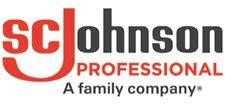


 By Hojung Nam and Hansol Lee
By Hojung Nam and Hansol Lee
Antimicrobial peptides (AMPs) are a promising new weapon for combating the growing antimicrobial resistance of bacteria and other harmful microorganisms. Now, researchers from the Gwangju Institute of Science and Technology developed a new, easily interpretable AI-powered prediction model named AMP-BERT that can capture the functional and structural properties of peptides and classify them as AMPs and non-AMPs. This study is a major stride towards the acceleration of AMP-based drug discovery and therapeutics.
Over the last few decades, antimicrobial resistance has become a major public health concern globally. This has led to a search for alternative methods of treating microbial infections. One such innovation is the discovery of antimicrobial properties of certain peptides. Antimicrobial peptides (AMPs) are short peptides found in most animals, plants, and microorganisms as a natural defense against infections. AMPs combat harmful bacteria via a nonspecific mechanism that prevents them from developing antimicrobial resistance. Despite these exceptional abilities, research on AMPs is being hindered because the existing systems for identifying candidate AMPs are like a black box, where the outputs are not easily interpretable for further analysis.
Now, in a recent breakthrough published in Protein Science, a team of researchers from Gwangju Institute of Science and Technology, including Prof. Hojung Nam and Mr. Hansol Lee, proposed an AMP-BERT classification system that uses AI-based bidirectional encoder representation from transformers (BERT) architecture to improve upon the existing AMP classification models. Their findings were published in print in Volume 32, Issue 1 of the journal in January 2023.
When asked about the motivation behind developing the classification system, Prof. Nam explains: “The misuse and overuse of antibiotics have resulted in the development of bacteria that cannot be effectively treated with these antibiotics. This has resulted in an increased health risk not only in humans but also agriculture. So, we wanted to develop an AMP pre-screening platform that isn’t a black box of algorithms but can be easily interpreted for further research.”
The team incorporated a natural language processing (NLP)-based deep neural network that was pre-trained with billions of protein sequences then fine-tuned with thousands of peptide sequences from a benchmark AMP database. This enabled the AMP-BERT model to not only extract the structural and functional information from the input peptide sequences but also differentiate AMPs from non-AMPs. This enhanced the prediction power allowed the model to make better classifications even with external data.
The team also designed the model to assign individual attention scores to each amino acid from the input peptide sequence. The attention feature then revealed the important subregions of AMPs that play a major role in deciding whether a peptide has antimicrobial properties or not. Furthermore, the prediction results indicated the AMPBERT model’s applicability extends even to unseen peptide data and that it can learn meaningful functional and structural information from those peptides.
The novel AMP-BERT peptide pre-screening model can open new doors for the discovery and development of AMP-based drug candidates for treating antimicrobial-resistant illnesses. The important peptide subregion information provided by this prediction platform can also be used to optimize the antibiotic efficiency of peptides. “As more AMPs are experimentally validated and new structural information is uncovered using computational methods, we will be able to
make more effective antibiotic drugs and potentially stop a new pandemic from spreading across the world in near future” concludes Prof Nam. AMP-BERT will certainly be a powerful weapon in our war against antimicrobial resistance.
The Gwangju Institute of Science and Technology (GIST) is a research-oriented university situated in Gwangju, South Korea. Founded in 1993, GIST has become one of the most prestigious schools in South Korea. The university aims to create a strong research environment to spur advancements in science and technology and to promote collaboration between international and domestic research programs. With its motto of “A Proud Creator of Future Science and Technology,” GIST has consistently received one of the highest university rankings in Korea. n H
Hojung Nam is an Associate Professor in the School of Electrical Engineering and Computer Science, and the AI Graduate School at Gwangju Institute of Science and Technology (GIST). She received her Ph.D. in the Dept. of Bio and Brain Engineering at the Korea Advanced Institute of Science and Technology (KAIST) and completed her postdoctoral training in the Dept. of Bioengineering at the University of California, San Diego (UCSD). Currently, her research group is working on the development of various computational tools for drug discovery, development, and models for the prediction of drug side effects. Hansol Lee is a Ph.D. candidate at GIST under Prof. Hojung Nam’s instruction. During his Ph.D. course, he has carried out research on AMP-related deep learning models, including AMP class prediction and AMP sequence generation.

Infection Prevention and Control Canada (IPAC Canada) has revised its Toys Practice Recommendations, in collaboration with the IPAC Canada Standards & Guidelines Committee and the IPAC Canada Paediatric and Neonatal Interest Group (November 2022). The following is an overview of the guidelines for use and cleaning of toys in healthcare settings. It is not the full and complete document. The entire Practice Recommendation, including elaboration on the points described in the overview, definitions and references can be found at ipac-canada.org/position-statements-practice-recommendations.

Patients, their siblings and families should have access to clean and safe
play equipment and toys in healthcare settings. Toys can be a reservoir for potentially pathogenic microorganisms that can be present in saliva, respiratory secretions, faeces or other body fluids. Healthcare providers must decide whether the benefits of an environment in which patients are free to interact with each other, share toys, and practice their social skills, outweigh the risks of infections that may be acquired.

Recommendations include:
Before and after playing with toys/ play equipment (e.g. playhouses/climbers), patients should be encouraged or assisted to clean their hands with
alcohol-based hand rub (ABHR) or soap and water (when visibly soiled). Play areas should have access to both ABHR and a hand wash station supplied with liquid hand soap; and paper
towers in dispensers. Hand hygiene with ABHR must be supervised by the designated support persons or staff (as applicable).
Continued on page 33
The green alternative is medical grade and certified while also biodegradable and compostable
St. Joseph’s Health Care London (St. Joseph’s) is the first hospital in Ontario to switch to a medical mask that protects more than staff, physicians, patients and visitors. It’s also safe for the planet.

The new green alternative mask is medical grade and certified while also biodegradable and compostable. Made from plant-based biopolymers from renewable crop resources, the mask not only meets the gold standard for protection, it boasts an impressive carbon offset – producing 65 percent less
CO2e emissions over its life cycle than a synthetic mask.
“As a long-time leader in environmental stewardship, St. Joseph’s is always seeking solutions and making changes to reduce our impact on the environment,” says Lori Higgs, Vice President Clinical Support and Chief Financial Officer at St. Joseph’s. “We are pleased to lead the way in the province with a switch to a green mask that is a healthy solution for the environment and our care teams.”
The environmentally-friendly mask is the VIRALOC eco™ mask pro-

Did you know that the nose is home to thousands of germs? Because it is a warm, moist cavity, it is an ideal breeding ground for many harmful pathogens. This includes infection-causing germs like influenza, coronaviruses, Staph aureus, and MRSA.
Ondine Biomedical has developed state-of-the-art photodisinfection technology to prevent and treat infections caused by any microorganism. Their lead product, Steriwave, targets a major – and largely unaddressed – reservoir of pathogens: the nose.
With a single, painless, 5-minute treatment, Steriwave immediately destroys all types of nasal bacteria, viruses, and fungi that can otherwise spread and lead to serious infections.
Unlike antibiotics, Steriwave does not create any microbial resistance. It
ONDINE BIOMEDICAL HAS DEVELOPED STATE-OF-THE-ART PHOTODISINFECTION TECHNOLOGY TO PREVENT AND TREAT INFECTIONS CAUSED BY ANY MICROORGANISM.
has been proven in leading Canadian hospitals to significantly reduce infection rates, length of stay, readmissions, and antibiotic use.
Steriwave is a game-changer in the fight against infections, having demonstrated effectiveness in preventing dangerous infections and helping hospitals gain bed capacity. n H
To learn more about this cutting-edge technology visit ondinebio.com/steriwave
duced by PADM Medical based in Winnipeg, MB. The selling feature for St. Joseph’s was an opportunity to significantly reduce consumption of single-use plastics without compromising on breathability, filtration or splash resistance. Due to the COVID-19 pandemic, face mask consumption and waste have become a global issue and a massive source of microplastic waste in the environment.
Across the organization, about 1.5 million masks are used per year at the current use rate – an increase of more than 800 per cent pre-pandemic. The VIRALOC eco™ mask is an ASTM F2100 Level 3 procedural mask and has replaced all masks provided to those working and training at St. Joseph’s as well as patients, visitors and volunteers.
The switch took place gradually. Stocking of the mask began at St. Joseph’s the week of Dec. 12, 2022 and was fully implemented by mid-January 2023.
“We were pleased to find a mask that not only protects all those who work or receive care at St. Joseph’s, but also benefits the environment,” says Toby O’Hara, General Manager of Healthcare Materials Management Services, which consolidates purchasing for St. Joseph’s and the region’s hospitals.
The new mask is also less expensive than St. Joseph’s previous level three masks.
The mask is currently used by major hospitals in Manitoba and Saskatchewan and multiple retirement homes across Canada.
“We are very excited to be working with St. Joseph’s Health Care London as the first Ontario hospital to fully integrate VIRALOC eco™ as a sustainable alternative,” says Kyle Fiolka, Chief Innovation Officer with PADM Group. “Our commitment is to creating eco-conscious products to support the health and wellness of all individuals and our planet.”
before they start
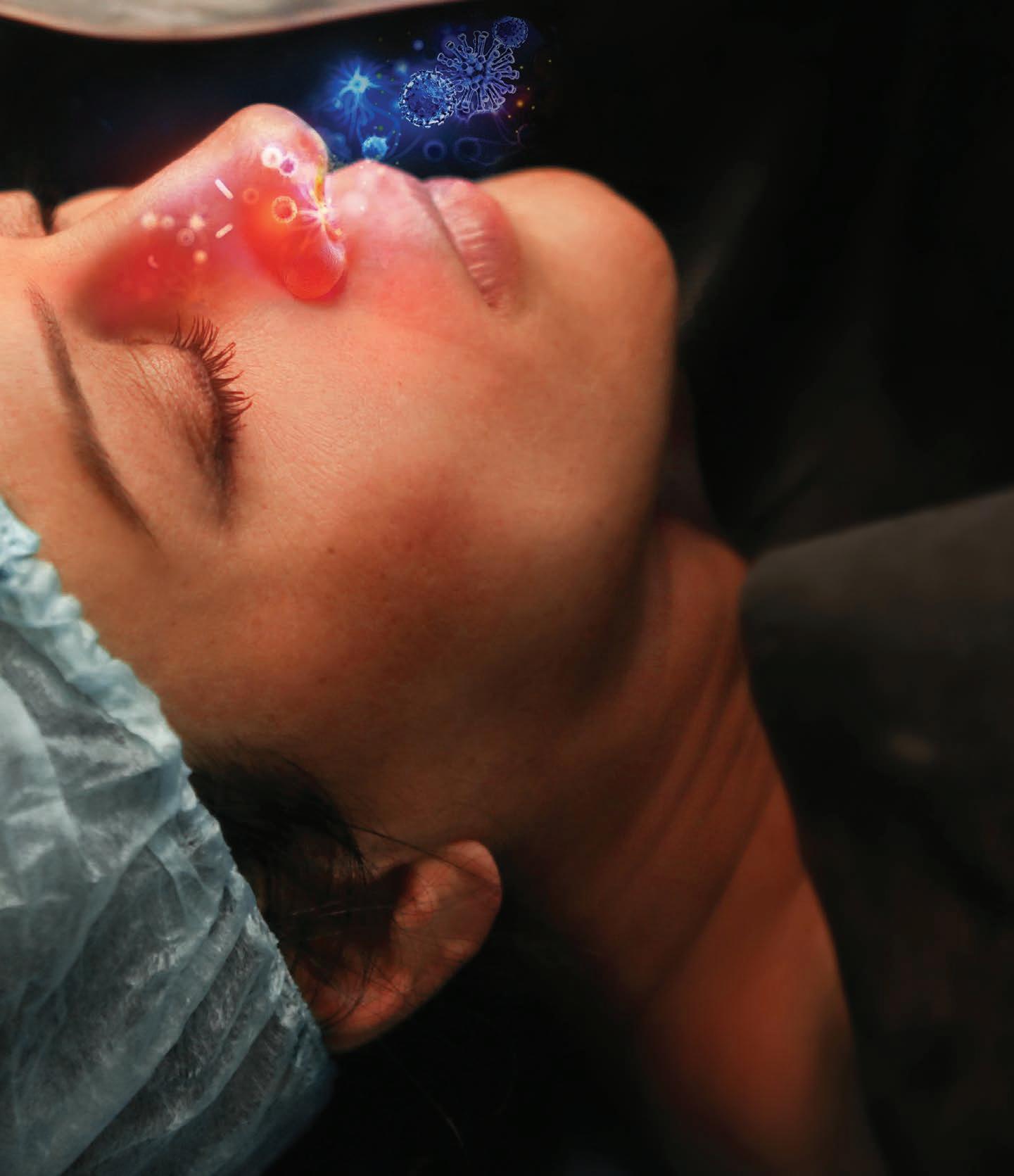


Infection prevention and control (IPAC) has been a core component of healthcare health and safety programs for as long as anyone can remember. Though the tools and options have changed over the years and even decades, pandemic or no pandemic, the goal has been the same, safe staff, patients and residents and their families.
With COVID, and all its variants, RSV and seasonal flu running rampant, infection prevention and control has become part of everyday language. It’s frequently in the headlines as stories of healthcare systems are stretched to the breaking point. (Could one ever have imagined a point where a hospital calls a Code Orange – without a mass casualty incident – or where children’s respite and palliative care staff have to be redeployed to address a surge in patients hospitalized with respiratory viruses.)
While some specific infections are making headlines, there are still so many others that remain a threat to both patients, families, residents, and healthcare workers and their families, and are fought on a daily basis both in health and community care settings. These could include MRSA, C Difficile, VRE, TB and scabies to name just a few.
The risks are clear. The emergence of new infectious diseases

The need for enhanced infection prevention while maintaining budgets has pushed facility management to rethink their environmental health & safety results. With “cleaning for health” as the new standard, efficient and effective processes are key. A precision cleaning approach and smart technology help monitor and measure performance to optimize returns and resources.
Capture photographic evidence of contamination on surfaces with Optisolve Pathfinder™. This surface imaging technology allows infection preventionists, environmental service managers, and cleaning teams to test hard non-porous surfaces for contamination. Users can now visually detect any risks, and fine-tune their cleaning practices for improved infection prevention, environmental monitoring, health and safety assurance, and facility performance.
As a registered GBAC Star™ product and technology Optisolve Pathfinder™ allows you to develop a precise cleaning program that puts infection prevention and environmental monitoring first. Reducing chemical usage, while planning the correct disinfecting and cleaning regimen needed to keep your facility clean, healthy, and safe. Visually proven with Pathfinder™ , and tracked with SOC 2 type 2 and HIPPA Compliant SAVI® Quality Management System.
Learn More about how Optisolve can provide your team with cleaning validation at optisolve.net/industries/health-care


and their ever-evolving variants, potential re-emergence of past diseases and ongoing threats of other respiratory hazards has highlighted the need for individuals and health and community care organizations to monitor and act.
The steps individuals must take have been made especially clear in the last almost three years. Wear and remove your PPE correctly, complete a pointof-care assessment, practice appropriate hand hygiene, and follow contact, droplet and airborne precautions.
The Public Services Health and Safety Association (PSHSA) (the provincial occupational health and safety training and consulting organization serving the government, public safety, education and healthcare sectors) has a number of tools and resources to help. Occupational health and infection prevention & control practices go hand in hand to ensure workers and the patients they care for remain safe. They both require organizations to start with a risk assessment to ensure they are prepared for any potential hazards that can affect the organization. In many cases an infectious disease threat can negatively impact both workers and patients/ clients if not properly controlled.
PSHSA offers self-serve options for organizations in the public sector to complete their own risk assessment including
• General Workplace Infectious Disease Risk Assessment Tool
This tool, found at https://bit.ly/PSHSA-IDRA, can assist organizations in building capacity to identify, assess and manage infectious disease threats.
• Infectious Disease Threat – Organizational Risk Assessment Tool for Acute Care
This tool was designed to enable the systems, structures, skills and culture to maintain readiness and to better protect healthcare workers, patients, residents, families and all Ontarians. It follows a six-step risk management process and is divided into two worksheets: risk identification and analysis and risk assessment and management. The tool can be found at https://bit.ly/PSHSA-IDRA-AC.
Infectious disease prevention and control isn’t just important in healthcare settings. Emergency services workers providing healthcare on the streets are exposed to infectious disease risks, so police, fire and paramedic services workers must have 24 hour access to a designated officer.
Designated officers are:
• the emergency services worker’s representative in investigating all reported exposures to communicable diseases.
• Support for the emergency services worker following an occupational exposure to a communicable disease
• A liaison with the public health unit PSHSA delivers the provincial designated officer training program and a self-assessment designed to help emergency services and justice services organizations evaluate their designated officer program. More information about the designated officer training can be found at https:// www.pshsa.ca/courses/designated-officer-training
While the highest risk has traditionally been the healthcare workplaces, there are other infectious disease risks that affect other sectors. To find out more about your sectors risk, check out the PSHSA’s is free elearning program at https://bit.ly/ PSHSA-IPAC.
Once a risk assessment has been completed, the organization must implement a program to ensure their staff are protected. One cornerstone protective measure that we all became aware of during the past three years is the need to prevent droplets and aerosols from entering our airways.
WEAR AND REMOVE YOUR PPE CORRECTLY, COMPLETE A POINT-OF-CARE ASSESSMENT, PRACTICE APPROPRIATE HAND HYGIENE, AND FOLLOW CONTACT, DROPLET AND AIRBORNE PRECAUTIONS.
In some cases that require the use of masks, but when providing direct care to patients or clients with infections, a higher level of protection by using a respirator is needed, and respirators require specific fit testing (as per the CSA Standard Z94.4-18). To address the need, the PSHSA developed its Training the Fit Tester for Respiratory Protection program. It provides participants with the knowledge and skills required to conduct qualitative fit testing on their own staff. If your staff may need to wear a respiratorfind out more at https://bit.ly/PSHSA-TTFT.


All levels within the healthcare system, including policy makers, facility managers healthcare workers and those accessing health services have to be committed to providing constant attention to IPAC. IPAC is unique in the field of patient safety and quality of care, as it is univer -





sally relevant to every healthcare worker, patient and resident, at every healthcare interaction. Without effective IPAC it is impossible to achieve quality healthcare delivery
and impossible to protect staff, patients, residents and their families and yours.
For more information about the PSHSA, its infection prevention and



control training and tools or consulting services, please visit our website at PSHSA.ca (https://bit.ly/PSHSA-Consulting), call 416-250-2131 or email clientexperiences@pshsa.ca. n H



 By Jennifer Stranges
By Jennifer Stranges
Machines that dispense free self-testing kits for HIV and COVID-19, naloxone kits, new needles, condoms and other essential harm reduction and sexual health supplies will soon appear in communities across Canada.


The ‘smart’ machines, called Our Healthbox, work like a vending machine, and also provide health information and a service directory for people to find much-needed health care and supports in their community. The initiative, led by researchers at St. Michael’s Hospital, a site of Unity Health Toronto, launched in four communities in New Brunswick on Jan. 23, with plans to launch up to 50 machines across Canada in 2023. The goal is to install 100 machines over the next three years, and to evaluate how

well they support people with their health needs.
The initiative launches as new HIV cases in Canada rise and the country’s opioid crisis claims the lives of 20 Canadians each day. Providing access to harm reduction and health care supplies for free to people in spaces they frequent is a strategy experts consider as key to reaching people who are underserved and who have barriers to accessing testing, harm reduction materials, treatment, care and prevention due to racism, homophobia, stigma and discrimination.
“Everyone in Canada deserves to have what they need, when they need it, to take care of their health. But we know that this is not the case, and so we are doing everything we can to bridge that gap in ways that work for each person in their community,” said Dr. Sean B. Rourke, a scientist at MAP Centre for Urban Health Solutions, a world-leading research centre housed at St. Michael’s Hospital, and the Director of REACH Nexus, a national research group working on how to address access and treatment for HIV, Hepatitis C and other sexually transmitted and blood-borne infections.
Our Healthbox is the latest phase of work led by Rourke to connect those with complex health and social circumstances to testing, treatment and prevention. In 2019, Rourke spearheaded a cross-Canada clinical trial which evaluated and proved the accuracy of HIVself tests – Health Canada approved the tests for use in November 2020 based on the results of the trial. In June 2022, Rourke launched the I’m Ready research program, distributing 10,000 free HIV self-testing kits across Canada to reach people who are undiagnosed and get them connected to care, with the goal of identifying the factors that affect access to testing and care.
Rourke and his team will work with local community-based organizations, public health authorities, and health centres to host and maintain Our Healthbox program. Each agency de-
termines the supplies needed in the machines to serve the people in their community. The east coast launch of Our Healthbox is funded by Even the Odds, a partnership between Staples Canada and MAP Centre for Urban Health Solutions.
“Our Healthbox will ensure underserved individuals in the community have low barrier access to resources that not only reduce their risk of infections, but in fact save their lives,” said Deborah R. Warren, Executive Director at ENSEMBLE, a community-based organization in Moncton, N.B. that works to address complex social issues by providing support, education and prevention initiatives. “We are currently in the midst of a substance use crisis that sees the death of one New Brunswicker every four days. Providing access to free naloxone will save many lives.”
Our Healthbox is funded by the Canadian Institutes of Health Research (CIHR), the Public Health Agency of Canada, the Canadian Foundation for AIDS Research (CANFAR), the St. Michael’s Hospital Foundation, and Even The Odds (Staples Canada and MAP). n H






The commitment for physicians to “do no harm” extends to the planet.
Right now, however, Canadian health care systems contribute 4.6 per cent of greenhouse gas (GHG) emissions from lighting, cooling and heating hospitals, single-use medical items such as syringes, transportation in the medical supply chain and a host of other standard practices across the continuum of care.
Recent data shows that from 2018 to 2019 alone, our per capita GHG emissions increased by 1.3% – the equivalent of more than nine million passenger vehicles on the road.
These emissions play a part in devastating ecosystems everywhere and directly impact human health.
Fossil fuel air pollution is believed to be responsible for one in five deaths worldwide. Heat waves can increase emergency room visits and ambulance
transports by 10 to 15%, which can exceed healthcare system capacity and reduce quality of care.
Underserved populations and patients whose health is already compromised are particularly at risk.
In 2021, Canada was one of more than 50 countries at COP26 to sign on to the World Health Organization’s initiative to develop climate resilient and low-carbon sustainable health systems.
The CMA is now calling on the federal government to establish a national secretariat to ensure cross-country coordination, and on all levels of
At PSHSA, we offer many training options with as many ways to learn, in order to meet your health and safety goals.
PSHSA offers limited, live, and in-person classroom training at our head office in Toronto. But maybe going at your own pace is preferable.
PSHSA also offers eLearning courses you can complete on your schedule. Once started, you have thirty days to complete the material. You are welcome to revisit course content whenever you need.
PSHSA also offers live distance learning in a virtual classroom taught by one of our experienced consultants.
Lastly, suppose you have ten or more colleagues or employees needing training. In that case, PSHSA offers on-site course delivery from the comfort of your workplace.
For organizations looking to update or refine existing plans, PSHSA consultants can help.
Flexible learning on health and safety is possible with PSHSA. With expert consultants ready to guide, over 100 health and safety courses available in multiple learning avenues, to customized digital learning solutions, PSHSA helps you and your organization make health and safety effortless.
Please visit www.pshsa.ca/training or contact your health and safety consultant www.pshsa.ca/consulting/find-a-consultant
governments, health care organizations and health care professionals in Canada to work towards a net-zero health goal.
The CMA is also committed to partnering with and being guided by First Nations, Inuit and Métis communities to advance and promote health care equity.
“Physicians witness the impact of climate change on patient health,” says CMA President Dr. Alika Lafontaine, “whether it’s smoke inhalation from wildfires, the spread of infectious diseases, heat stroke, or a host of other preventable issues. We have a duty to act in the best interests of our patients, and our planet.”
Strategies for net-zero health care
1. Expand virtual care
2. Create a robust primary health care system to alleviate pressure on hospitals
3. Support healthy living, including addressing the determinants of health, encouraging healthy eating and active living
4. Use energy efficiently, shifting to renewable energy sources and reducing the need for fossil fueled generators in hospitals
5. Practice sustainable prescribing, including reusable packaging when appropriate
6. Focus on community care to ensure health promotion and disease prevention, especially in rural and remote communities
7. Reduce waste through recycling and medical device reprocessing programs
8. Prepare for future climate emergencies with training and preparedness plans
9. Implement climate resilient infrastructure, such as flood doors and improved ventilation
Choose sustainable procurement and health supplies. The majority of health sector emissions are embedded in the supply chain, including pharmaceuticals and medical devices. Clinicians can reduce waste and preferentially use lower-emission supplies. For example, by following appropriate prescribing guidelines to reduce unnecessary testing and treatments, and choosing reusable rather than single use medical devices, when possible.
Consider appropriate use of health services. The CMA is advocating for the implementation of robust primary care systems in Canada that everyone can access. Where appropriate, clinicians can help mitigate unnecessary use of hospital services by facilitating access to primary and community care service.
Reduce overall demand for health care. Integrative and comprehensive health care includes focusing on the determinants of health, chronic disease management, disease prevention and health promotion. Keeping people healthy will reduce the demand for energy intensive health services
The CMA is pressing for action as a partial response to the climate crisis as well as ongoing health inequities. A net-zero health system will lead to a healthier planet and a healthier population.
Learn more about the CMA’s work at www.cma.ca/our-focus. n H
A broad suite of training opportunities… and almost as many ways to participate.This article was submitted by the Canadian Medical Association.
Toys should be selected based on Health Canada’s safety guidelines and regulations and be nonporous, smooth/ non-textured and able to withstand rigorous mechanical cleaning and disinfection. Toys that are shared must be cleaned and disinfected. Toys not able to be cleaned should be designated to a specific patient. Items that are not able to withstand cleaning and disinfection (e.g. puzzles, books, motorized compassion/companion pets) should be avoided. Use should be based on organizational risk assessment. If these are to be used, hand hygiene is to be performed before and after handling these items.
Designated support persons should be encouraged to bring a limited number of the patient’s favourite toys from
home. These toys are to be stored in a cleanable container, kept at the patient’s bedside and labelled with the patient’s name. Toys brought from home are not to be shared and are to be cleaned and disinfected on a regular basis or when visibly soiled. If a personal toy is visibly dirty, it should be the responsibility of the parents to ensure it gets cleaned and disinfected, taken home (and not brought back to the healthcare settings) if unable to be cleaned and disinfected, or discarded.
Play areas that are used by more than one patient should have an area for segregation of dirty toys (e.g. labelled/marked bin ‘Used Toys’ into which parents/families/staff can place used/mouthed toys. Clean and disinfected toys should be stored in a manner that prevents contamination (e.g. dust and water splatter) and should be clearly marked as clean.
Toys should be inspected for damage, cracked or broken parts each time the toy is cleaned and disinfected as these may compromise cleaning. Any toy that is found to be damaged, cracked or broken should be discarded.
INCLUDE:
Option 1: Use a dedicated commercial, NSF-approved dishwasher/ cart washer that sanitizes using either hot water (e.g. 82oC for 10 seconds) or a chemical sanitizing agent. Do not clean toys in dishwashers normally used to clean and sanitize dishes and utensils used for food service.
Option 2: Clean toys manually prior to disinfection, or use a 1-step cleaner/disinfectant product. Unless otherwise specified by the manufacturer, replace disinfectant solution after each use. Phenolics must not be used for toys or equipment that come into contact with infants. If a disinfectant is used, toys must be rinsed with potable water thoroughly after cleaning and disinfection. Allow toys to air-dry, in a manner that prevents contamination, prior to storing.



An audit process should be in place to monitor adherence to the policies to further minimize potential infection risk. n H

TOYS THAT ARE SHARED MUST BE CLEANED AND DISINFECTED. TOYS NOT ABLE TO BE CLEANED SHOULD BE DESIGNATED TO A SPECIFIC PATIENT.
new infection-control tool is now in place at hospitals across the Fraser Health region and will soon be implemented at long-term care sites.
Staff and medical staff are seeing blue – and that’s a good thing. The standard bleach wipes used to wipe down surfaces are now sporting a bright blue hue, courtesy of a disinfection system known as Highlight.


• PCS Hypochlorous Acid products reduce environmental impact of surface cleaners and disinfectants all are classified as nonhazardous by WHMIS.
• PCS Hypochlorous Acid cleaners and disinfectants contain only natural inorganic ingredients that decompose to inorganic salts providing no organic ingredients that microbes could degrade and use as a food source.
• Some of the world’s largest manufacturers of retail and institutional cleaners have had to recall millions of containers of detergents. All the products recalled had the potential for large growth of bacteria like Pseudomonas.
• We assume bacteria have evolved sufficient resistance to the preserving action of the cleaners and began consuming the biodegradable cleaning ingredients as food for growth. It is only a matter of time before many more biodegradable cleaners become contaminated.
• Clorox Recalls 37 million Bottles of Pine-Sol That May Contain Bacteria.
• Colgate-Palmolive, Recalls Fabuloso MultiPurpose Cleaners Due to Risk of Exposure to Bacteria 4.9 million containers.
• Laundress has recalled over 8 million laundry detergents & other products for the presence of dangerous bacteria. The Consumer Product Safety Commission said the recall involves Art of Green Free and Clear laundry detergent and Zen Lavender Garden laundry detergent. Laundry detergent recalled over possible bacterial contamination.
1.877.745.7277
Highlight colors the disinfectant wipes so staff can see where they’ve cleaned. The blue fades to clear if the cleaning is thorough. If the color remains, additional cleaning is required.
It’s a win-win for patients and staff as cleaning and disinfecting reduce the risk of infections such as Clostridioides difficile (C. difficile), carbapenemase-producing organisms (CPO), Candida auris (C. auris), and methicillin-resistant Staphylococcus aureus (MRSA).
“This is one of the first products we’ve brought into Fraser Health that can be
tal surfaces where the virus lingers. Therefore, Ebola treatment workers wear protective equipment that must be removed only after it is sprayed completely with bleach.
Columbia University students developed an additive powder for bleach that didn’t alter the efficacy of the bleach but turned it blue. Medical teams could then visualize the complete coverage and disinfection of their protective gear, thus reducing the risk of accidentally transmitting Ebola.
Out of this innovation, the company Kinnos was born. Two of the orig-
used system-wide by both housekeepers and clinical staff,” says Jody Miller Elliot, Director of Housekeeping Strategies and Initiatives, Fraser Health. “We can see where the chemistry is applied on the surface to disinfect.”
The new system has its roots in the 2014 Ebola epidemic that originated in West Africa and spread to other regions including North America. Ebola virus is transmitted by direct contact with the blood or other body fluids of an infected individual and/or indirectly through contact with environmen-
inal founders still lead the company today and helped train Fraser Health managers and staff on how to use the Highlight system.
“Highlight is simple and effective, and the time was right to bring it in because the repatriation of housekeeping services allowed us to streamline our products and protocols,” says Miller Elliot. “We are the first health authority in Canada to use this system-wide, and it’s the first time it has been implemented on such a wide scale.” n H
HIGHLIGHT COLORS THE DISINFECTANT WIPES SO STAFF CAN SEE WHERE THEY’VE CLEANED.
This product is a broad-spectrum virucidal hard surface disinfectant that is expected to inactivate the SARS-CoV-2 (the virus that causes COVID-19) Kills 99.99% of bacteria and viruses, Kills 99.99% of germs, Kills Staphylococcus aureus, Pseudomonas aeruginosa, Human Coronavirus, and Adenovirus Type 5 Broad Spectrum Virucide, Bactericide/Virucide PCS 1000 Plus pH –neutral oxidizing disinfectants are available in ready to use or dispense on-demand formats.
DIN: 02521431
• Oxidizing cleaner
• Oxidizing hospital grade disinfectant
• This product is a broad-spectrum virucidal hard surface disinfectant that is expected to inactivate the SARS-CoV-2 (the virus that causes COVID-19) AND OTHER ENVELOPED AND NON-ENVELOPED VIRUSES
• Active Ingredient
Sodium Hypochlorite - 0.13% w/w when packed
Hypochlorous Acid - 0.01% w/w when packed
• Color/Form Colorless, liquid
• pH 6.5 - 8.5
• Ready-to-use solution
• Scent Characteristic of ingredients slight bleach sent
• Shelf Life 1 year
• PCS 1000 Plus Oxidizing Disinfectant Cleaner for use on hard non-porous environmental surfaces in domestic, health care facilities, institutions, schools and hospitality industries
Contact Time Broad Spectrum Virucide and Hospital Disinfecting
Virus Enveloped • 2 Minutes
Non Enveloped • 3 minutes
Bacteria Staphylococcus Aureus, Pseudomonas • 5 minutes
*PCS is in the process or has submitted to Health Canada Request for additional claims

Clostridium difficile spore form
Spray disinfectant 1 minute contact time Bacteria and Broad spectrum virucide Adenovirus type 5
We create our Hypochlorous Water by diluting PCS concentrated stabilized sodium hypochlorite disinfectant with purified water to the desired concentration of sodium hypochlorite and add dilute solution of acetic acid to the desired pH range 6.5 to 8.5 creating PCS Hypochlorous Acid.
“At environmental pH values (6.5-8.5) half of the hypochlorite is in the undissociated form of hypochlorous acid and half is dissociated to the hypochlorite anion. Only the hypochlorous acid fraction is volatile”
*Amend the Hypochlorous acid and sodium hypochlorite concentrations to 0.07% for each.
Concentrate
DIN: 02521504
• Oxidizing cleaner
• Oxidizing hospital grade disinfectant
• This product is a broad-spectrum virucidal hard surface disinfectant that is expected to inactivate the SARS-CoV-2 (the virus that causes COVID-19) AND OTHER ENVELOPED AND NON-ENVELOPED VIRUSES
• Contains 2 % sodium hypochlorite
• Concentrate when diluted through NPH dispenser contains the Active Ingredient
Sodium Hypochlorite - 0.13% w/w when packed
Hypochlorous Acid - 0.01% w/w when packed
• Color/Form Colorless, liquid
• pH 12.45 (Concentrate)
• pH 6.5 - 8.5 at use dilution
• Scent Characteristic of ingredients bleach odour
• Shelf Life 2 years (Concentrate), 30 days (Use Dilution)
• PCS 1000 Plus Oxidizing Disinfectant Cleaner Concentrate for use on hard non-porous environmental surfaces in domestic, health care facilities, institutions, schools and hospitality industries.

US Patent No 11,103,840 issued August 31st 2021
A mixing and dispensing device and method. In particular, the device used by the applied method reduces the risk of chlorine gas formation while providing a stable, effective and safe disinfectant in the form of a hypochlorous acid and sodium hypochlorite mixture.

For parents, the decision to vaccinate their kids against SARS-CoV-2 is complex, influenced by scientific evidence, political and social pressures, and views about individual versus collective benefits of vaccination, according to a new study published in CMAJ (Canadian Medical Association Journal).
Researchers conducted a qualitative study with in-depth interviews of 20 parents to understand their views about SARS-CoV-2 vaccination, with a goal to support future vaccination initiatives.
“Given the observed discrepancy between parental intention and decision to vaccinate their children against SARS-CoV-2, it is important to understand how and why parents make their decisions,” said Dr. Jonathon Maguire,
a pediatrician at St. Michael’s Hospital, a site of Unity Health Toronto, and the University of Toronto. “Understanding the factors that influence parents’ decisions about SARS-CoV-2 vaccination for their children would help improve public health policies and interventions as well as inform health care professionals about parents’ perspectives and concerns.”
Few previous studies have explored how parents make decisions to vaccinate, or not vaccinate, their children once eligible for vaccination.
The decision was challenging for most parents in the study. Parents’ considerations related to the following:
• The newness of SARS-CoV-2 vaccines and evidence supporting their use
• Perceived politicization of guidance for vaccination
Meet the challenges of the ongoing pandemic with rapid, on-demand detection of SARS-CoV-2. Our next generation of Xpert Xpress CoV-2 plus test is designed with enhanced coverage to test symptomatic and asymptomatic patients, enable better variant detection, and mitigate the possible effects of viral genetic drift.
• Detect SARS-CoV-2 as soon as 20^ minutes for positive results
• Testing for symptomatic and asymptomatic* patients
Speed, plus Accuracy, plus Peace of Mind
That’s the PCRplus advantage. From Cepheid. Learn more at www.cepheid.com *IVD.

• Social pressures around SARSCoV-2 vaccination
• Weighing of individual versus collective benefits of vaccination
These findings have implications for communicating information on SARS-CoV-2 vaccination.
“Future guidance should highlight both individual and collective benefits of SARS-CoV-2 vaccination for children; however, health care providers should prioritize individualized discussions with parents to help interpret evidence, consider their understanding of risks and benefits, and provide tailored recommendations,” said Dr. Janet Parsons, a research scientist at St. Michael’s Hospital, a site of Unity Health Toronto, and an
associate professor at the University of Toronto.
Health care providers have a key role to play in supporting parents in decision making.
“It is important for health care providers to understand that parents who seem hesitant to vaccinate their children may have a variety of reasons for feeling this way and may be reticent to ask questions to health care providers for fear of stigma,” said Dr Parsons. The authors recommend that these conversations be approached with empathy and openness.
“Parents’ perspectives on SARSCoV-2 vaccinations for children: a qualitative analysis” was published February 21, 2023. n H
“IT IS IMPORTANT FOR HEALTH CARE PROVIDERS TO UNDERSTAND THAT PARENTS WHO SEEM HESITANT TO VACCINATE THEIR CHILDREN MAY HAVE A VARIETY OF REASONS FOR FEELING THIS WAY AND MAY BE RETICENT TO ASK QUESTIONS TO HEALTH CARE PROVIDERS FOR FEAR OF STIGMA.”

The Canadian Coalition for Green Health Care is pleased to be offering the Green Hospital Scorecard to facilities across Canada, thanks to support from our new partner – Health Canada!
As hosts of Canada’s only comprehensive environmental benchmarking tool for health care, the Coalition is excited to continue our focus on helping organisations measure their performance in a number of areas including water, energy, waste, pollution prevention, leadership, food, transportation and climate change-related resilience and mitigation.
Health Canada’s commitment to climate resilience and mitigation makes them a perfect partner to help
us deliver our survey to fit the growing need for climate action in health care facilities.


The 2022 Green Hospital Scorecard survey (2021 data) will be released in March 2023, stay tuned for the data call announcement.
Please contact autumn@greenhealthcare.ca if you want to learn more, or have any questions on the Scorecard.
The Canadian Coalition for Green Health Care is Canada’s premier green health care resource network and is leading the evolution of sustainability in Canada’s health sector as a national voice and catalyst for environmental change. Our vision is a resilient, sustainable and low-carbon health system. https://greenhealthcare.ca/ n H


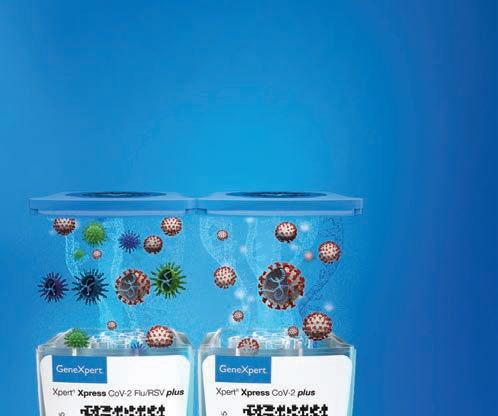
single-dose of the antiviral drug peginterferon lambda reduced by half the risk of hospitalization or a visit to the Emergency Department due to COVID-19, according to a study published today in the New England Journal of Medicine.
The multi-centre phase 3 TOGETHER clinical trial – designed to test a new therapy in a real setting – evaluated the use of this drug in more than 1,900 outpatients at high risk of developing complications from COVID-19.
Patients who received a single-dose subcutaneous injection of peginterferon lambda within seven days of their first COVID-19 symptom had a 50 per cent lower risk of needing to be admitted to hospital when compared to people who received a placebo.

The trial was one of the first to test treatment in a largely vaccinated population. The research team found that a similar effect was seen in those who had received the vaccine – 84 per cent – as in those who were unvaccinated. The team also saw the benefits of treatment across multiple COVID-19 variants, including the highly transmissible Omicron variant.
This study follows a previous phase 2 trial performed at UHN that showed that peginterferon lambda accelerated clearance of the virus.
“This much larger trial shows us that the antiviral benefits we previously observed translate to clinical benefit. The results conclusively show that this is an effective therapy to treat COVID-19 to reduce the risk of complications,” says Dr. Jordan Feld, one of the lead authors of the study and Interim Director of the Toronto Centre for Liver Disease and Co-Director of the Schwartz Reisman Liver Research Centre and the R. Phelan Chair in Translational Liver Research at UHN.
“An important feature of this treatment is that it is not affected by changes or mutations in the virus, because it works by stimulating the body’s own
response to viral infection,” added Dr. Feld, who is also a Senior Scientist at the Toronto General Hospital Research Institute at UHN and a professor in the Department of Medicine at the University of Toronto.

Study participants reported few or no side effects, with no significant differences seen between the group that received the actual treatment and the group that received a matching placebo.
“This could be an important addition to our arsenal to fight COVID-19, especially for high-risk patients who may not be able to use currently avail-
able treatments because of side effects or drug interactions with medications they take,” says Dr. Feld.
All participants were either aged 50 or older, or had a health condition that put them at higher risk for severe COVID-19, such as diabetes, hypertension, obesity, transplant recipients and cancer patients, among other conditions. The effect of the treatment was even more pronounced in people who received the drug within three days of symptom onset, consistent with other antiviral medications for COVID-19.
The study was done in partnership with the Pontifical Catholic University of Minas Gerais, Brazil, where first author Dr. Gilmar Reis and his team recruited the majority of participants and helped analyze the data. The study was also done in collaboration with Dr. Edward Mills, at McMaster University, and Professor Jeffrey Glenn at Stanford University.
The TOGETHER Study is a phase 3 trial that was based on the phase 2 study led by Dr. Feld in Toronto last year. n H
Dr Jordan Feld“AN IMPORTANT FEATURE OF THIS TREATMENT IS THAT IT IS NOT AFFECTED BY CHANGES OR MUTATIONS IN THE VIRUS, BECAUSE IT WORKS BY STIMULATING THE BODY’S OWN RESPONSE TO VIRAL INFECTION.”







The United Brotherhood of Carpenters’ Infection Control Risk Assessment (ICRA) training teaches healthcare construction protocols that save lives.

Our training educates Healthcare Personnel, Construction Professionals and Architects in ICRA best practices that protect patients by working safely during all phases of healthcare facility renovations.
Contaminants released during renovation projects can lead to deadly healthcare associated infections. This is why it’s critical for anyone working in a healthcare facility during renovation to have participated in ICRA Training.

With the UBC ICRA training, you’ll learn necessary safeguards to protect your patients from health hazards during construction.
1 in 25 hospital patients has at least one healthcare associated infection at any given moment
1.7 million patients suffer from healthcare associated infections every year nationwide
100,000 deaths resulting from healthcare associated infection occur each year
GermStopSQ has been issued a Notice of Compliance by Health Canada and granted a Drug Identification Number, making Good Theorem the first to launch a residual* disinfectant that keeps killing 99.999 per cent of bacteria and 99.9 per cent of Human Coronavirus 229E for 24 hours, making it the first of its kind on the market.
Canada continues to face the effects of viruses and bacteria. Flu season arrived early with a vengeance and has hit children and those more vulnerable especially hard. Disinfectants currently on the market provide no lasting disinfecting protection against harmful germs that contribute to the spread of viruses and bacteria. After a surface is cleaned it can be immediately re-contaminated – until now.
After years of research and support from various levels of government, in-
CANADIAN COMPANY, GOOD THEOREM, LAUNCHES FIRST AND ONLY GOVERNMENT APPROVED RESIDUAL* DISINFECTANT THAT KEEPS KILLING 99.999 PER CENT OF BACTERIA & 99.9 PER CENT OF HUMAN CORONAVIRUS 229E FOR 24 HOURS.
cluding the Department of National Defense, Good Theorem was able to successfully bring to market a residual disinfectant that would break industry barriers.
“GermStopSQ has been a long time coming and now as the first and only product of its kind with a Health Canada DIN designation, we are excited to offer it nationwide,” said Jared March, CEO, Good Theorem. “We have seen the rise in flu and COVID cases, especially among children. By using GermStopSQ companies can now add
a layer of protection that will help stop the spread of bacteria and viruses in any school, facility, office, or hospital in a way no other cleaning product or disinfectant can do.”
GermStopSQ is truly unique in its residual disinfectant that was tested under the U.S. EPA Interim Method, and it keeps killing 99.999 per cent of bacteria and 99.9 per cent of Human Coronavirus 229E for 24 hours. But its benefits don’t stop there:

A liquid disinfectant that is Healthcare-grade and a Broad-spectrum virucide. This makes it perfect for hospitals, medical offices, schools, offices and stores.
Only needs to be applied to a surface once a day for continuous protection, reducing cost and re-contamination on high touch surfaces.
Employees, customers and guests can now have the reassurance that applied surfaces are always protected from Bacteria and Human Coronavirus 229E.
“I’m always looking for innovative, smart and cutting-edge opportunities to invest in and support. I am particularly looking for solutions that can help as many people as possible,” stated Joe Mimran, investor and advisor in Good Theorem. “GermStopSQ solves for all of that. And the fact that it was created here in Canada and has global potential is certainly something we are all proud of.”
The research and development for GermStopSQ was developed by Envi-
sionSQ, a company out of Guelph, Ontario. EnvisionSQ is a research and development company that tackles some of the world’s greatest health issues. Its innovative technologies create cleaner, safer environments for families and communities around the world.
The high-efficacy liquid starts to kill bacteria and viruses on contact when it is sprayed. After it has dried, a thin invisible coating forms on non-porous, hard surfaces. When that surface becomes contaminated (by someone touching it, or air droplets landing on it), that’s when GermStopSQ goes to work as it attaches to, penetrates, ruptures, and neutralizes the microbe. The coating lasts 24-hours without losing its efficacy, even under conditions of frequent touching and rubbing.
Good Therorem seeks out scientific innovation to create meaningful brands with differentiated products. In addition to GermstopSQ, Good Theorem has licensed the rights to products with other technological advances in the cleaning and wellness space that will be introduced to customers in 2023. n H










This is why Sani Marc offers its Sani Marc eAcademy®, an online training platform that provides a wide range of interactive courses, video demonstrations, protocols, guides, certifications and more. This value-added service is offered exclusively to Sani Marc clients*.


*Certain conditions apply.

 By Kent Waddington and Linda Varangu
By Kent Waddington and Linda Varangu
Through collaboration with long-term care (LTC) and retirement home (RH) partners and with funding support from Ontario’s Independent Electricity System Operator (IESO), the Canadian Coalition of Green Health Care has developed a comprehensive made-in-Canada environmental benchmarking tool designed specifically for the LTC/RH sector. Stakeholders are now invited to take part in piloting this FREE first-of-itskind benchmarking tool.
The tool will help LTC and RHs identify, measure and report on their environmental performance; helping enable sector-wide benchmarking of energy use, water use and waste management, pollution prevention, corporate leadership, food, transportation and climate change, that can
be used by senior leaders to improve decision-making to advance sustainability and environmental performance. Hospital corporations or health authorities who are aligned with LTC may find this scorecard useful to address sustainability issues in LTC facilities

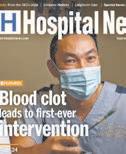

Assembling these metrics will be supported by a new web-based tool (online tool) to assist LTC/RH users in collecting the Scorecard data. The online tool will facilitate data tracking
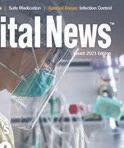
and monitoring for the sector and will be used to populate a participants confidential and unique web-based dashboard. Some LTC/RHs have already begun reporting on their environmental and sustainability initiatives through an online questionnaire created by the Coalition.
The pilot LTC/RH scorecard continues the Coalition’s focus on helping Canada’s health care organisations measure their environmental performance, improve their climate change resiliency and lower their ecological footprint. Why Participate? Ultimately, your participation will provide the LTC/RH sector with important information and insights about overall environmental performance and energy consumption. As well as:
• Help measure your internal environmental performance to improve your sustainability initiatives;


• Help reduce your energy and greenhouse gas emissions using Canada’s first environmental evaluation tool for the LTC/RH sectors;
• Provide you and senior leaders with important information to help guide budgeting and planning, highlight anomalies (i.e., fuel consumption, waste management fees, etc.) and assist in more informed decision-making;
• Identify potential areas for improvement to environmental performance and operational efficiency unique to your organisation; and
• Receive a high-level snapshot of your organisation’s environmental






performance against a backdrop of de-identified peer data

It may also position participants to better pursue funding support programs such as IESO’s Save on Energy program in Ontario.
To participate, email the Coalition’s Project Coordinator, Autumn Sypus, autumn@greenhealthcare.ca and she will set you up with you own unique and confidential survey link so you can start submitting your 2021 data before May 10th, 2023. The Coalition will be happy to organise a Zoom meeting to provide you with step-by-step instruction if required.
The Coalition also recently released a new FREE downloadable guidebook highlighting key steps and actions senior leaders can initiate and support for their organisation to move them towards a climate-resilient, carbon net-zero, and environmentally-sustainable health system. Intended as a primer to help the LTC/RH sector transition to a greener system, the document is an excellent source of inspiration for those starting their journey.
Download Environmental Stewardship: An implementation guide for boards, management, and clinical staff – Meeting Long Term Care Standards and beyond at: https://greenhealthcare.ca/guidebooks/
To learn more about IESO’s Save on Energy program, please visit: https:// www.saveonenergy.ca/For-Your-SmallBusiness/Programs-and-Incentives
The Canadian Coalition for Green Health Care is Canada’s premier green health care resource network and is leading the evolution of sustainability in Canada’s health sector as a national voice and catalyst for environmental change. Our vision is a resilient, sustainable and low-carbon health system. https://greenhealthcare.ca. n H
It is no longer hyperbole to say that we are witnessing our health system moving slowly but surely to a point from which it will be very difficult to return.
Despite the weighty First Ministers meeting with the Prime Minister on healthcare last week, complete with a lot of promises, health workers continue retreating from the system, as they have for the last year, in a sort of slow-motion form of resistance.
Health workers are reducing their hours from increasingly toxic work environments, moving to more attractive positions in the private sector or leaving their professions entirely.
The work of health care has always been challenging but work environments at present can only be described as toxic because of shortages of workers, because of the endemic and rising levels of violence and because they can’t do the job they love, taking care of those who need it under such circumstances.
The work of health care lacks support for our health workers.
Canada’s health workers are sounding the alarm and we must heed their wake-up call. The meeting should have been about our opportunity to reform the health system to better support health workers, better care for our population and ultimately create a more sustainable system that will be there when we need it regardless of our age.
Governments need to act swiftly and boldly. The days of incremental change have passed.
The recent First Ministers meeting announcements addressing needed supports for health workers are a step in the right direction. But is it enough?
Across each of the identified areas of shared priority – primary care, service backlogs, mental health and substance use, health system modernization – a strong health workforce will be required to deliver on these initiatives. Thankfully, solutions to support health workers are at hand.
Report after report has called for action to address the immediate issue of retention – to stop the bleeding of health workers from our public health systems. Provincial/territorial governments – with support from the federal government – should spread and scale evidence-informed retention initiatives with targeted investments in partnership with employers and health authorities.
Employers should be supported by all levels of government to act decisively to foster safe, healthy and supportive work environments.
We also need to foster the return of health workers who have retreated from the public healthcare system. Provincial and territorial governments should fund flexible return-to-practice programs. Employers should provide mentorship and other supports bridging workers’ return to work.
Other workers we need to return to work in our health systems are those in Canada with international training.
The federal government should enhance supports for bridge training and mentoring programs. Provincial/ territorial governments should support these health workers while training and continue to encourage regulators to streamline the licensure recognition process. Employers should implement paid mentorship and support from experienced practitioners to ease integration pathways.
Strategic and supported recruitment pathways are also needed.
Here, the federal government should target tuition support for work of a broad range of health workers in underserved sectors and communities. In partnership with provincial and territorial governments, it should also support faculty recruitment to enable increased capacity in the training system.
Employers should support the training capacity of clinical faculty through funded secondments in partnership with universities and colleges. Provincial/territorial governments should
also scale programs that support transitions from training to employment.
The spread of these and other promising retain-return-recruitment initiatives from other jurisdictions requires dedicated leadership, infrastructure and funding.
Once these measures are implemented on multiple fronts, we need to look at upstream strategies to help prevent future crises. Here the meeting announcement to create a Centre of Excellence on health workforce data is crucial.
Enhanced health workforce data accessible through interactive platforms will enable various decision-makers to embed health workforce planning into their ongoing decision-making processes. This is the role that such a Centre should support. This should include digitally enabled tools for employers and re-
gional authorities to integrate into their ongoing planning.
Provincial/territorial governments would be better supported to initiate or reinstate integrated health workforce planning in collaboration with educators, regulators, employers and unions/professional associations. And employers would be better able to utilize human resource information systems to embed ongoing planning for safe staffing.

Leaving these chronic health workforce issues unaddressed has critical impacts beyond the workforce itself. Patient safety, quality care and health system sustainability are also at risk. There are also implications for the economy, as we’ve all witnessed. Let’s listen to and support health workers.
It is imperative that all levels of government act now. n H
Dr. Ivy Lynn Bourgeault is a Professor and Research Chair at the University of Ottawa and the Lead of the Canadian Health Workforce Network.HEALTH WORKERS ARE REDUCING THEIR HOURS FROM INCREASINGLY TOXIC WORK ENVIRONMENTS, MOVING TO MORE ATTRACTIVE POSITIONS IN THE PRIVATE SECTOR OR LEAVING THEIR PROFESSIONS ENTIRELY.
 By Daria Adèle Juüdi-Hope and Dania Versailles
By Daria Adèle Juüdi-Hope and Dania Versailles
As we wrap up this year’s Black History Month, Black nurses have a message: We are tired of waiting on the sidelines for change. For far too long, we have been subjected to and have witnessed structural racism within nursing organizations, regulatory bodies, associations and the broader health system.
If Black lives really do matter, we must experience change within the nursing profession. The mere act of creating organizational anti-racism plans on paper is not enough. These plans must be made public, as must their progress indicators – and their outcomes.
As members of the Registered Nurses’ Association of Ontario’s (RNAO) Black Nurses Task Force, we feel privileged to be part of a group that is galvanizing the necessary energy to lead and advocate for the changes we know must happen. The task force issued 19 recommendations aimed at dismantling anti-Black racism in health-care organizations and nursing education programs. And, our group, the Black Nurses Leading Change Interest Group (BLNC), is continuing the work of challenging and removing the barriers Black nurses face.
We bring our experiences and our own perspectives as Black nurses. We know what it is like to be passed over for promotion. We know what it is like to be ignored, disrespected, not heard. We know what that sense of “otherness” feels like. We have been demeaned by colleagues, patients, or families. In a survey of 205 Black nurses and nursing students, 88 per cent reported experiencing racism and discrimination in their work. Imagine for a moment, the suffering and the negative impact this has on one’s mental and physical health, one’s livelihood, and one’s career path. This is a public threat that cannot be ignored. It affects the health and wellbeing of Black nurses; it limits their contributions to the health system and it interferes with their ability to provide safe and compassionate care to Ontarians.
But we also need to deal head on with the root causes of systemic racism. This requires holding all staff in health organizations accountable for addressing racial discrimination and developing strategies to combat it. We also need to develop and enforce transparent policies on anti-racism such as zero tolerance for staff, nursing leaders, patients and families.
At a time when Ontario is experiencing a nursing crisis, can we really afford to drive away more nurses because of how we mistreat them? And, yet that is the risk if we do not take concerted action. We are working collectively to centre the stories and experiences of Black nurses, engage in political advocacy, and demand transformative action. Priority recommendations include the need for urgent advocacy and partnership with allies to address racism against Black nurses, create great-
er mentorship and support for Black nurses and students, embed anti-racism content in nursing curricula, call for equitable and fair human resources processes, and collect race-based data.

Many of us have often felt that our knowledge and expertise were not valued. Too often, colleagues and leaders only see the colour of our skin. RNAO’s BNLC interest group represents what nursing can look like in our workplaces and on the front lines. We offer mentorship, support, a sense of community, and educational and career opportunities for Black nurses and nursing students to thrive in work and study places.
Our health system needs substantial improvements to dismantle and address anti-Black racism within nursing. We need to level the playing field through advocacy, meaningful collaboration and transparent accountabil-
ity mechanisms. And, we need more awareness of systemic racism among health-care providers, leaders and community members.
We strongly feel that had we had a similar group earlier on in our careers, we would have felt encouraged to further our careers and take on leadership roles early on. It could have changed the course of our careers. Too often, expertise of Black nurses have been wasted because a group like this did not exist.
We are leading the way by continuing the important work built on the strong foundation laid by the work and report of RNAO’s Black Nurses Task Force. We continue to call on senior leadership in nursing workplaces and academic settings to tackle structural racism.
RNAO’s BNLC offers us a safe space to collaborate, connect, advocate for anti-Black racism, provide mentorship and continuing education, every day –not just one month a year. Our group is powering this social movement. We hope that nurses and nursing students around the world see us as champions against anti-Black racism and discrimination. And, we call on all nurses and nursing students to stand up for Black colleagues in their workplaces and nursing programs. n H
Daria Adèle Juüdi-Hope RN, BScN, MPH is Co-Chair of RNAO’s Black Nurses Leading Change Interest Group and Dania Versailles, RN, BscN, MScN CPMHN (C) is Co-Chair of RNAO’s Black Nurses Leading Change Interest Group.THE MERE ACT OF CREATING ORGANIZATIONAL ANTI-RACISM PLANS ON PAPER IS NOT ENOUGH. THESE PLANS MUST BE MADE PUBLIC, AS MUST THEIR PROGRESS INDICATORS – AND THEIR OUTCOMES.


 By Dr. Carole Estabrooks
By Dr. Carole Estabrooks
Despair.” “Guilt.” “Hell.” “Traumatizing.” “This was my Crimean War.”
These are the words of nursing home managers talking about their work experiences during the early part of the COVID-19 pandemic.
Like Florence Nightingale and her nurses who coped with poor sanitation, supply shortages and overwhelming numbers of wounded soldiers during the 1850s Crimean War, nursing home leaders and their frontline staff worked tirelessly under gruelling conditions in the early months of COVID-19 to care for residents and keep them safe.
Despite their best efforts, the virus swept through many nursing homes, sickening and killing thousands of residents and staff. The deaths, lockdowns, severe staffing shortages and overwhelming workloads COVID-19 brought have taken a toll on everyone
associated with long-term care, including the managers and directors of care responsible for frontline staff and ensuring good quality of care for residents.
Two studies that my colleagues and I recently published reveal that these leaders are exhausted, at risk of burnout and considering leaving their job or the nursing profession altogether. We cannot afford to lose them.
Workforce shortages are already a long-standing problem in nursing homes and leaders have a direct effect on staff turnover and the quality of care the homes provide. Governments and other decision makers need to understand the profoundly negative effect that the pandemic has had on nursing home leaders and develop and adopt policies and strategies to better support them.
One of our studies involved interviews with 21 nursing home leaders
from eight nursing homes in Alberta and British Columbia between January and April 2021. The managers we interviewed felt a tremendous sense of responsibility for protecting residents, staff, and their own families from COVID-19 and were devastated when the virus made it into their nursing homes. One manager called it a “kick in the stomach,” as she described the despair she felt seeing staff and residents sick and dying from COVID-19.
Managers also reported experiencing grief and guilt for residents isolated from their families and for sick and dying residents and staff who contracted
COVID-19 at their nursing homes. Nursing home leaders had to deal with overwhelming workloads resulting from frequent changes in public health orders, often with short notice, that left them scrambling to put new measures in place. Staff shortages sometimes required them to do frontline care as well as their administrative duties. Many worked weeks without any time off.
One nursing leader described the period as “probably the worst experience of my 40 years in nursing,” saying, “There were a few mornings I’d come in when I should have six health care aides

Home care is about trust. It is feeling comfortable with a provider coming into the home of someone you care for and, possibly, assisting with the most intimate care.


Bayshore’s home care services are extensive, varied, and personalized for each individual. Whether it’s just a little assistance for daily tasks or round-the-clock care, Bayshore’s caregivers can help your loved ones to live their best life while remaining at home.
1.877.289.3997
and two LPNs [licensed practical nurses] and there was myself and two health care aides to run this floor of 34 patients sick with COVID. It was traumatizing!”
The second study shows how managers’ scores on important quality of work life and health measures deteriorated over time. For this study, we surveyed 181 care managers at 27 nursing homes in Alberta in February 2020, before the pandemic, and in December 2021, 21 months into it.
Comparing the results from both sets of surveys, we found that as time went on, nursing home leaders experienced significant decreases in job satisfaction, mental health and confidence in being able to do their work. Their levels of exhaustion and cynicism rose, putting them at risk of burnout.
Prior to the pandemic, these measures had been stable for more than a decade.
Nursing home leaders also reported carrying a tremendous “burden of worry” about the mental health and well-being of their staff, which added to their own stress and exhaustion.
Some leaders said they were contemplating resigning or retiring from nursing, citing the overwhelming workload and stress, lack of support and recognition, feeling ineffective and personal/ family issues as the reasons.

The studies’ findings paint an alarming picture of leaders stretched to the limit emotionally, mentally and physically as they strived to meet the needs and expectations of residents, families, senior management, staff, regulators and the public during a very chaotic period.
And it is not over. They continue to face residents and staff who are sick, and staff shortages that leave them unable to provide the care that residents’ need. COVID and its ongoing aftermath haven’t gone away.
Given the serious workforce shortages and other issues already facing nursing homes, we cannot afford to ignore these findings. Governments and policy makers need to act now to address the concerns raised and find ways to support these leaders. n H



















Essity’s leading global brand TENA® o ers a range of skin care solutions. TENA Proskin™ 3 step solution is proactive in preventing incontinence associated dermatitis.


TENA ProSkin™ products help maintain skin integrity by keeping the skin’s natural moisture balance. All the formulas are gentle on the skin and come in a scent free formulation.

Health and service providers have felt the impact of Covid-19 on their mental health. The impact has been similar on family caregivers who support a family member, friend or neighbour. In fact, 58% say they feel burnt-out as a result of their caregiving role.
The next time you meet a family caregiver, let them know the Ontario Caregiver Organization is here to help.
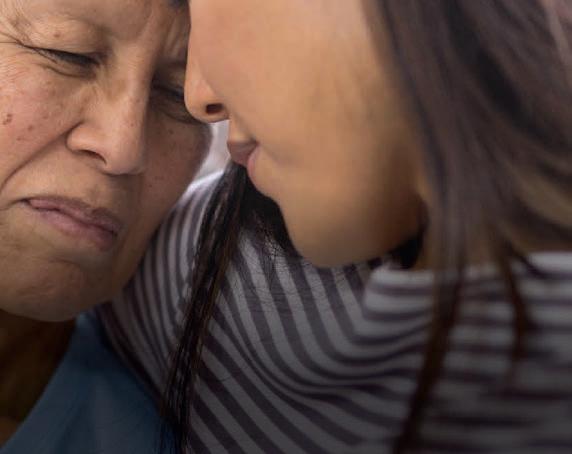

Free programs and services are available to Ontario caregivers: 24/7 Helpline (1-833-416-2273)
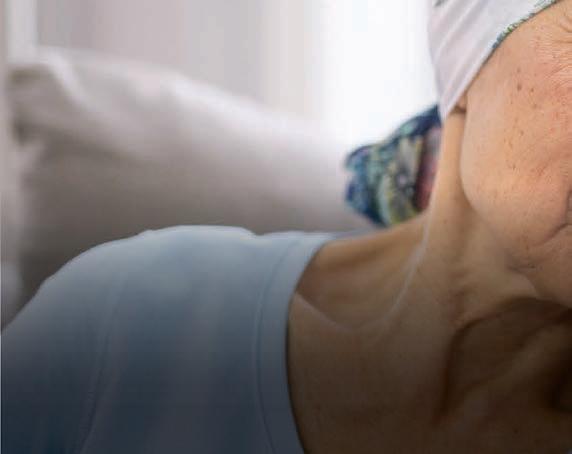
Helpful Webinars (Live and Recorded)
e-Learning and Educational Resources
Dedicated Resource for Young Caregivers: youngcaregiversconnect.ca

Group and 1:1 Peer Support (online or by phone)
Group and 1:1 Counselling Toolkits for Caregivers (For New and Working Caregivers)
Time to Talk Podcast
90Second Caregiver
Learn more at ontariocaregiver.ca